
Day 1, November 5 – Kiligolf
On November 5, 2022, I got my friend Raymond and Nick (father and son) visiting from England. We were supposed to do my standard 2 week Usambara trip, but Ray as a boy had read about the rift valley so we agreed on a 2 day extension going up the Rift Valley´s Eastern wall to Karatu and from there bird the Ngorongoro crater rim. The day after we would visit Lake Manyara NP. The Crater rim was very good, but I found out why I had only been once to Lake Manyara NP. They arrived with Ethiopian from Addis midday so we had a chance to do some birding on Kiligolf in the late afternoon.
Here are some of the birds recorded on Kiligolf the first afternoon: Crested Francolin, Speckled Pigeon, White-bellied Go-away-bird, Black Crake, Greater Painted Snipe, African Goshawk, Blue-naped Mousebird, African Hoopoe, Red-fronted Tinkerbird, Brubru, Tropical Boubou, Long-tailed Fiscal, Magpie Shrike, Red-faced Crombec, Singing and Winding Cisticola, Sombre Greenbul, Pale White-eye, Wattled and Superb Starling, Spotted Flycatcher, White-browed Scrub Robin, Spotted Palm Thrush, Scarlet-chested, Marico and Variable Sunbird, Spectacled, Vitelline Masked and Chestnut Weaver, Crimson-rumped Waxbill, Purple Grenadier, Red-cheeked Cordonbleu, Red-billed and African Firefinch, Yellow-spotted Bush Sparrow and Reichenow´s Seed-eater.
Some pictures from Day 1:

Purple Grenadier, Granatina ianthinogaster, Endemic to NE Africa

Winding Cisticola, Cisticola marginatus

Black Crake, Zapornia flavirostra

Red-cheeked Cordonbleu, Uraeginthus bengalus

Long-tailed Fiscal, Lanius cabanisi, Endemic to NE Africa
Day 2, November 6 – Lark Plains – Oldonyo Sambu – Monduli Mountains
On the second day we first went to visit the Lark Plains. From the turn off we found amongst others, the following species, Foxy Lark, Eastern Chanting Goshawk, Southern Grosbeak Canary, Hildebrandt´s Starling, Rosy-patched Bushshrike, Taita Fiscal, Chestnut-bellied Sandgrouse, Banded Parisoma, Capped Wheatear, Red-capped and Rufous-naped Lark, and Tawny Eagle. We parked the car and spotted my Masai friends that had already found our primary target species: Beesley´s Lark. We looked for the Athi-short toed and Short-tailed Lark, but could not find them. We walked back to the car and drove slowly towards my Masai friends Boma. Here are some of the birds we observed on the way: White-backed Vulture, Northern and Isabelline Wheatear, Yellow-bellied Eremomela, Kori Bustard, Fischer´s Sparrow-Lark, White-bellied Canary, Fischer´s Starling, Chinspot batis, Blue-capped Cordonbleu and Short-tailed Lark (in a place I had never seen it before). We parked in the shade of an acacia tree and had breakfast. After breakfast we took a walk in the dry acacia forest next to my Masai friends boma. Some of the birds we observed included White-headed Buffalo Weaver, Pygmy Falcon, Grey-capped Social Weaver, Red-tailed Shrike, Beautiful Sunbird, Rosy-patched Bushshrike, Red-billed Oxpecker, Brubru, Yellow-spotted Bush Sparrow, Red-fronted Barbet, Red-throated Tit, Pygmy Batis, Red-fronted Prinia, Black-faced Waxbill, Abyssinian Scimitarbill, Buff-bellied Warbler, Kenya Sparrow, Northern White-crowned Shrike and Ashy Cisticola. We returned to the car and drove to our next destination Oldonyo Sambu. Here are some of the species we observed there: Augur Buzzard, White-fronted Bee-eater, Red-and-yellow Barbet, Lesser Honeyguide, Pale White-eye, Schalow´s Wheatear, Long-billed Pipit, Chestnut Sparrow and Little Rock Thrush. We had bagged all our targets at Oldonyo Sambu so we returned to the car and drove off to our next destination, just north of Lengijave Village. Our prime target here were Lyne´s Cisticola. Other birds observed included: Spotted Eagle-Owl, Northern Fiscal, Red-rumped Swallow, Arrow-marked Babbler, Schalow´s Wheatear, Bronze Sunbird, Baglafecht Weaver and Streaky Seed-eater. We drove back to the main road and turned right to get up to Monduli Mountains. This site proved to be a disappointment that day and we only managed to add a few new species: Cape Robin Chat, Red-rumped Swallow, Hunter´s Cisticola, African Stonechat, White-eyed Slaty Flycatcher, Willow Warbler, African Yellow Warbler, African Dusky Flycatcher and Mottled Swift. It was time to return to my house where we arrived just before Dark. We freshened up, Selvine and my maid, Neema had made a delicious meal for us and we retired early to bed.
Some pictures from day 2:

Beesley´s Lark, Chersomanes beesleyi, Endemic to a small area north of Arusha, Tanzania

Brubru, Nilaus afer

Rosy-patched Bushshrike, Telophorus cruentus, Endemic to NE Africa

Grey-capped Social Weaver, Pseudonigrita arnaudi, Endemic to NE Africa

White-fronted Bee-eater, Merops bullockoides

Little Rock Thrush, Monticola rufocinereus, Endemic to NE Africa

Long-billed Pipit, Anthus similis

Lyne´s Cisticola, Cisticola distinctus, Endemic to East Africa

Bronzy Sunbird, Nectarina kilimensis

Hunter´s Cisticola, Cisticola hunteri, Endemic to East Africa

African Stonechat, Saxicola torquatus
Day 3, November 7 – Tarangire NP – Karatu
On the third day of my Usambara trip we normally head for Tarangire National Park. The park is one of my favourites when it comes to birding. The park also contains plenty of mammals where lion sightings are not rare. It is about a 2 hour drive to the park so we started early and were close to the gate at around 08:00. There is a nesting colony of Rufous-tailed Weavers there. Some of the other birds observed at that site included Silverbird, Northern Red-billed Hornbill, Cut-throat Finch, Swahili, Kenya and Chestnut Sparrow, Yellow-collared Lovebird, Blue-cheeked and Red-capped Cordonbleu, Red-billed Buffalo Weaver and Red-bellied Parrot. We drove to the park entrance where my guide, Isaac, took my friends for a walk while I made the arrangement to enter the park. They picked up a few birds at the gate including Nubian Woodpecker. Once inside the park on our way to our breakfast spot we added amongst others these birds to our list: Black-chested Snake Eagle, White-backed Vulture, White-headed Buffalo Weaver, Ashy Starling, Magpie Shrike, African Grey Hornbill, Namaqua Dove, Martial Eagle, Secretarybird, Grey-headed Kingfisher, Coqui Francolin, African Hoopoe, Tawny Eagle, Pallid Harrier, Southern Ground Hornbill, Speckle-fronted Weaver, Brown-crowned Tchagra, White-bellied Bustard, Bateleur, Rüppel´s Vulture, Long-tailed Fiscal, Von der Decken´s Hornbill, Arrow-marked Babbler, Blue-naped Mousebird, Brown Snake Eagle, African Grey Flycatcher, Wahlberg´s Eagle, Spotted Flycatcher, Chestnut-bellied Sandgrouse, Cardinal and Bearded Woodpecker and Bare-faced Go-away-bird. We had now reached public Campsite number 1, where we had breakfast. After breakfast we continued our drive. Here are some of the new birds we added to our list: D´Arnaud´s Barbet, Gabar Goshawk, Eastern Grey Woodpecker, Red-billed Oxpecker, Pearl-spotted Owlet, Red-and-yellow Barbet, Common Ostrich, African Harrier Hawk, Black-headed Oriole, Greater Honeyguide, Slate-coloured Boubou, Klaas´s Cuckoo, Spotted Palm Thrush, Striped Kingfisher, Yellow-spotted Bush Sparrow and Yellow-necked Spurfowl. We reached our lunch site at around 13:00 and enjoyed the packed lunch that Selvine and Neema had provided. The lunch spot provides the furthest spot we go into the park and on the way out I alway use a different route. On the way out we added the following species: Red-necked Spurfowl, Double-banded Courser, Fischer´s Sparrowlark, Buff-crested Bustard, Spotted Thick-knee, Black-faced Sandgrouse, Banded Parisoma, Chestnut-bellied Sandgrouse, Hildebrandt´s Starling, Long-tailed Fiscal, Black-bellied Bustard, Crested Francolin, Banded Martin, Rosy-patched Bushshrike, Vitelline Masked Weaver, Northern White-crowned Shrike and Green-winged Pytilia. We reached the gate around 16:00 and set out for Karatu where Isaac had booked us accommodation. He had negotiated the price, but when he saw we were three Wazungu (White men) and one local Tanzanian, the prices changed fast. With a little negotiation, both the hotel Manager and I were happy. We had dinner at the restaurant and ordered packed breakfast and lunch for the day after.
Here are some pictures from day 3:

Rufous-tailed Weaver, Histurgops ruficauda, Endemic to N Tanzania and S Kenya

Silverbird, Empidornis semipartitus

Pallid Harrier, Circus macrourus

Martial Eagle (Juvenile), Polemaetus bellicosus

Secretarybird, Sagittarius serpentarius

Yellow-necked Spurfowl, Pternistis leucoscepus, Endemic to NE Africa

Bearded Woodpecker, Chloropicus namaquus

Klaas´s Cuckoo, Chrysococcyx klaas

Striped Kingfisher, Halcyon chelicuti

Ashy Starling, Lamprotornis unicolor, Endemic to Tanzania

Double-banded Courser, Rhinoptilus africanus

Spotted Thick-knee, Burhinus capensis

Black-faced Sandgrouse (female), Pterocles decoratus, Endemic to NE Africa

Black-faced Sandgrouse, Pterocles decoratus, Endemic to NE Africa
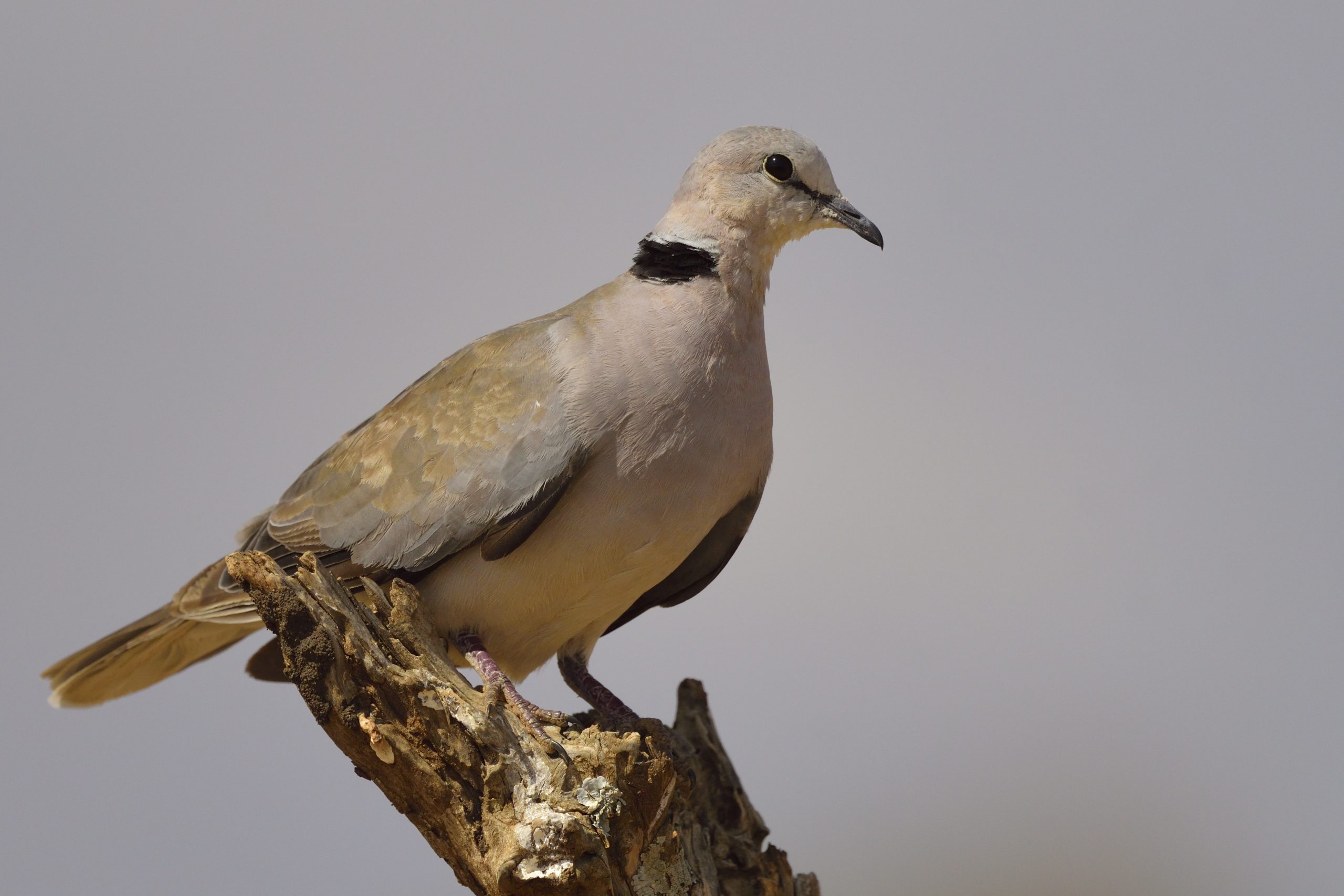
Ring-necked Dove, Streptopelia capicola
Day 4, November 8 – Ngorongoro Crater Rim – Karatu
Since Raymond wanted to see the rift valley, I had decided to bird the Ngorongoro Crater Rim this morning. Melissa, a friend mentioned that it was a good idea to take the route towards Sopa Lodge in order to avoid all the traffic to the crater and onwards to Serengeti. I have been to the Crater several times myself, but do not see that the cost going down there justify the birds you can find. We started off from Karatu in the morning and were at the gate to Ngorongoro Conservation Areas at 07:00. While I went to pay the entrance fee, my guide, Isaac, took my friends for a bird walk just around the gate. When I was finished paying, I could not find them they had been hiding behind the toilets finding amazing birds. Amongst them were Grey-capped Warbler, Cinnamon-chested Bee-eater, White-tailed Blue Flycatcher, Thick-billed Seed-eater, Brown-headed Apalis, Bronzy and Eastern Double-collared Sunbird. We got in the car and drove slowly up to the viewpoint over the crater. Here are some of the birds we picked up on the way: Mountain Greenbul, Cinnamon Bracken Warbler, Mbulu White-eye, Southern Citril and Brown Woodland Warbler. We stopped at the Viewpoint and took some pictures before we headed on the road towards Sopa Lodge. We stopped and had our packed breakfast at a nice viewpoint and continued on the road to the exit to Sopa Lodge. We registered amongst others these birds: Hunter´s Cisticola, Brown Snake Eagle, Yellow-billed Kite, Hildebrandt´s Spurfowl, Crowned Eagle, Red-tailed Shrike, Red-faced Cisticola, Mountain Buzzard, Golden-winged Sunbird, White-backed Vulture, Spectacled Weaver, Grey-headed Nigrita, Abyssinian Thrush, Northern Fiscal, Bar-throated Apalis, Eastern Grey Woodpecker and Brown Parisoma. We turned back at the entrance to the Sopa Lodge and saw many of the same birds as on the way in, but in addition: Cape Robin Chat, Pied Wheatear, Cape Crow, Schalow´s Turaco, Fan-tailed Widowbird and African Yellow Warbler. We had now past the viewpoint and reached our lunch spot. We had lunch while we observed a Yellow-billed Kite trying everything to steal our lunch. In addition we saw Red-collared Widowbird and Baglafecht Weaver at the lunch spot. We drove on towards the entry to the crater, but time was starting to run out on us. New birds picked up included Winding Cisticola, African Stonechat, Rufous-naped Lark, Streaky Seedeater and Tree pipit. At the airstrip, we had nice views of a pair of Hildebrandt´s Spurfowls. We exited the gate at exactly 18:00 and took some lovely pictures of the birds behind the toilet again :-). We returned to our hotel in Karatu, had dinner and retired early to bed.
Some pictures from Day 4:

White-tailed Blue Flycatcher, Elminia albicauda (TZ lifer for me, only seen in Rwanda before)

Grey-capped Warbler, Eminia lepida, Endemic to East Africa

Ray, me and Nick at the Crater Viewpoint
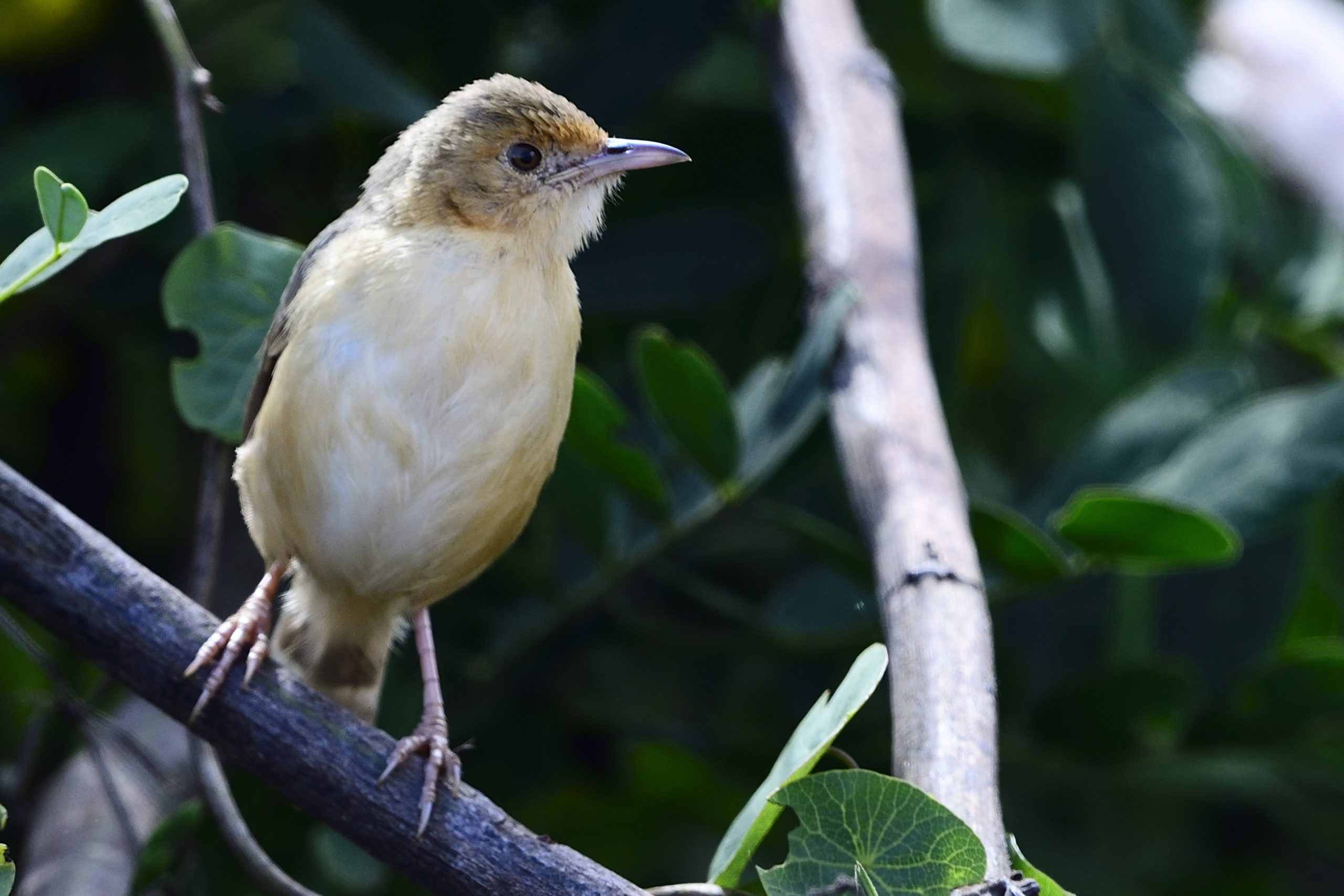
Red-faced Cisticola, Cisticola erythrops

Grey-headed Nigrita, Nigrita canicapillus
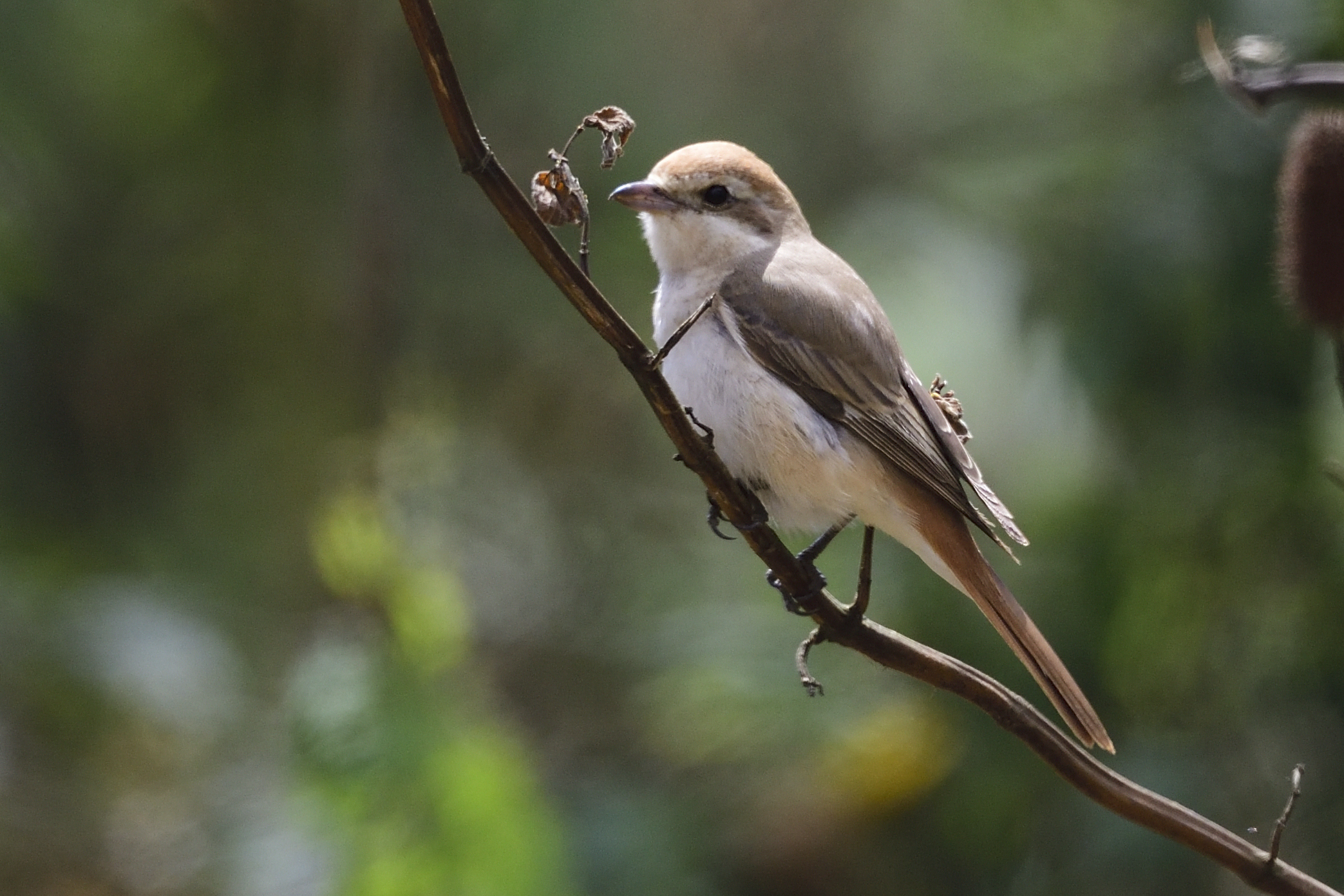
Red-tailed Shrike, Lanius phoenicuroides

Cinnamon Bracken Warbler, Bradypterus cinnamomeus

Baglafecht Weaver, Ploceus baglafecht

Brown Parisoma, Sylvia lugens (TZ Photo lifer)

Yellow-billed Kite, Milvus aegyptius
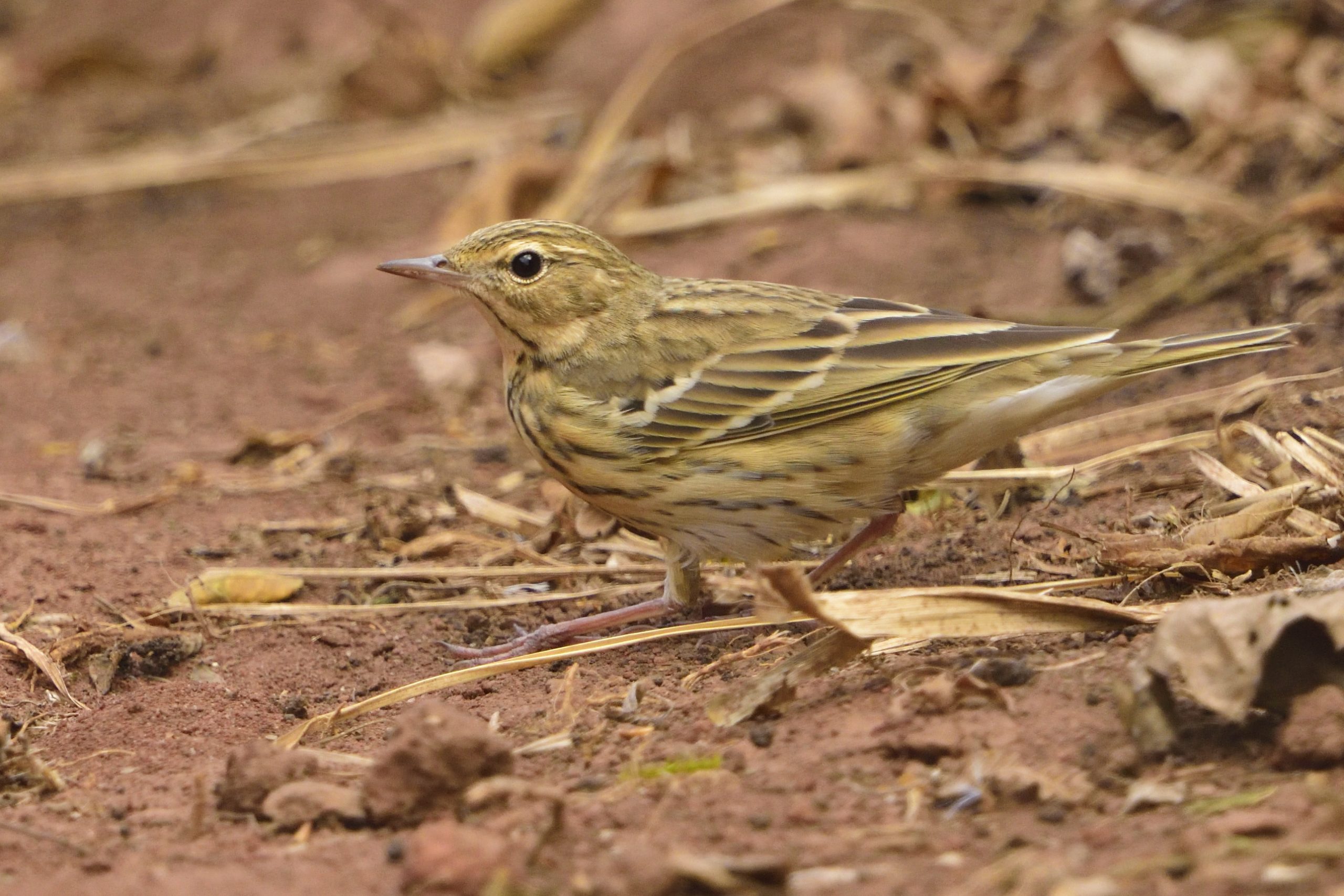
Tree Pipit, Anthus trivialis

Thick-billed Seed-eater, Chritagra burtoni

Brown-headed Apalis, Apalis alticola
Day 5, November 9 – Lake Manyara NP and Nanja
We left our hotel in Karatu and were by the Lake Manyara gate around 07:00. I had only been to this park once and there were a reason for that. In my opinion, this park does not hold any special birds. When we visited, the lake were also very high so it was very hard to access the sites for the many water birds there. Anyway we drove from the gate and some of the birds we registered before breakfast included Grey-headed Kingfisher, Blue-naped Mousebird, Pale White-eye, Crowned Hornbill, Spotted Palm Thrush, Yellow-breasted Apalis, Northern Brownbul, Lesser Masked Weaver, Orange-breasted Bushshrike, Red-rumped Swallow, White-crested Helmetshrike, Mosque Swallow, Rüppel´s Robin-Chat, Red-fronted Tinkerbird, European Bee-eater, Mountain Wagtail, Green Sandpiper, Red-throated Twinspot, Tawny Eagle, Slate-colored Boubou, Scaly-throated Honeyguide, Yellow-bellied Greenbul, Black-headed Oriole, Green-winged Pytilia, Red-and-yellow Barbet, Northern White-crowned Shrike, Von der Decken´s Hornbill, and Chestnut Weaver. We stopped at a picnic site around 09:00 and had breakfast. While having breakfast we observed amongst others Eurasian Golden Oriole and Fischer´s Lovebird. After breakfast we drove on and here are some of the birds we found: Crested Francolin, White-throated Robin, African Grey Flycatcher, Blue-capped Cordonbleu, Nubian Woodpecker, Banded Parisoma, Intermediate Egret, Spot-flanked Barbet and Grey-headed Bushshrike. We turned the car and tried to access the lake, but most of the roads were under water. Still we managed to pick up a few Shorebirds and other birds. Here are some of them we registered: Great White Pelican, White-headed Saw-wing, Ruff, Crimson-rumped Waxbill, Northern Red-billed Hornbill, Chestnut Sparrow, White-backed Vulture (on a nest), Glossy Ibis, Long-toed Lapwing, Three-banded Plover, Crested Guineafowl, African Goshawk, Saddle-billed Stork, Black Heron, African Paradise Flycatcher, Black Heron, African Fish Eagle, Hamerkop and African Sacred Ibis. It was only a little past 13:00 when we reached the gate again. My plan was to continue to the Eluanata Dam near the Masai village Nanja since we dipped on Northern Pied Babbler in Tarangire. My friends agreed and soon we were underway. We arrived at the site a few minutes before 14:30 and started ticking birds: Yellow-collared Lovebird, Chestnut Sparrow, Hildebrandt´s Starling, Kenya Sparrow, Grey-crowned Crane, Marico Sunbird, White-headed Buffalo Weaver, Fischer´s Sparrow-Lark, Southern Red Bishop, Pygmy Falcon, Beautiful Sunbird, Yellow-billed and Marabou Stork, Black-headed and Grey Heron, Blacksmith Lapwing, Northern Pied Babbler, White-bellied Canary, Namaqua Dove, African Hoopoe, Speckled Pigeon, Wattled Starling, Common-ringed Plover, Wood and Marsh Sandpiper, Ruff, Red-billed and Blue-billed Teal and a huge flock of Lesser Flamingos. There were very little water in the dam so instead of driving back to the main road where we came from, I took a short cut and ended up quite a few km west of Nanja. We drove home, had a nice dinner prepared by Selvine and Neema and then retired early to bed.
Some pictures from Day 5

Green Sandpiper, Tringa ochropus

Scaly-throated Honeyguide, Indicator variegatus
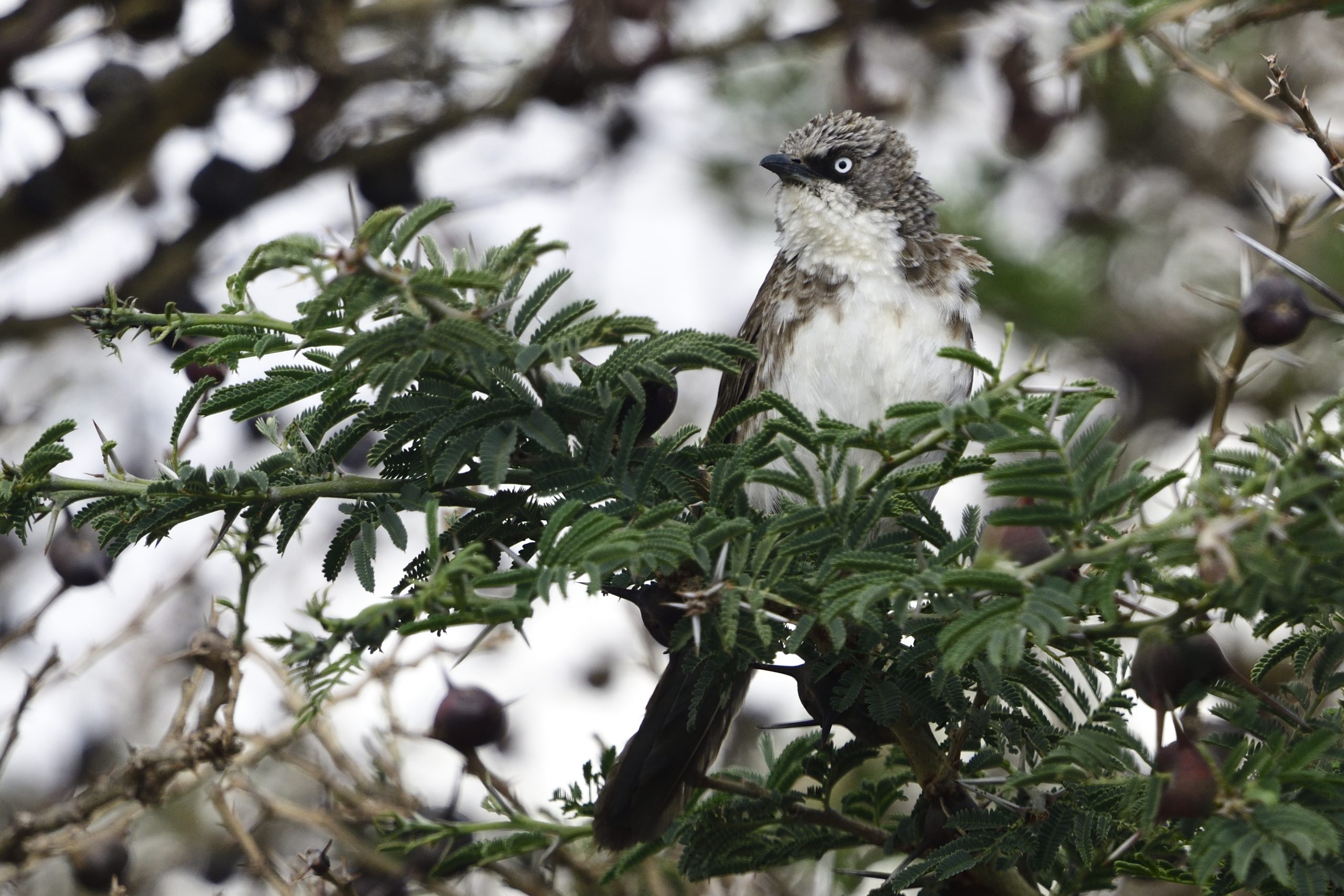
Northern Pied Babbler, Turdoides hypoleuca, Endemic to East Africa

Grey Crowned Crane, Balearica regulorum

Pygmy Falcon, Polihierax semitorquatus

African Hoopoe, Upupa africana

Blacksmith Lapwing, Vanellus armatus
Day 6, November 10 – Masai Steppes
Now, we were back on my regular trip itinerary and the destination that day were the Masai Steppes accessed from the little town of Mererani. This is only about an hour drive from my home, so we were there where the tar ends already at 06:50. We popped up the roof of my Landy and started birding. Here are some of the species we registered before our breakfast break: Pink-breasted Lark, Fischer´s Sparrow-Lark, Vitelline Masked Weaver, Winding Cisticola, Pygmy Batis, White-headed Mousebird, Tsavo Sunbird, Sombre Greenbul, Northern Brownbul, White-bellied Go-away-bird, Slate-colored Boubou, Bare-eyed Thrush, Eastern Grey Woodpecker, Buff-crested Bustard, D´Arnaud´s and Black-throated Barbet, Eastern Violet-backed Sunbird, Pied Wheatear, Red-fronted Prinia, Chestnut Sparrow, Speckle-fronted Weaver, Black-faced Sandgrouse, African Grey Flycatcher, Purple Grenadier, Eurasian Hobby, Red-bellied Parrot, Pale White-eye, White-bellied Canary, Reichenow´s Seedeater, Chestnut Weaver, Von der Decken´s Hornbill, Parrot-billed Sparrow, Fischer´s and Golden-breasted Starling, Beautiful Sunbird, Estern Chanting Goshawk, Black-necked Weaver, Blue-capped Cordonbleu, Red-billed Oxpecker, Northern Crombec and Red-and-yellow Barbet. We had now reached our breakfast spot and had breakfast in the shade of a tree. After breakfast we took a walk in an area that normally is very productive, but on that day, we hardly found any birds. We addded Hunter´s Sunbird and Gabar Goshawk on the walk. We continued in the car to our turning spot and picked up Scaly-throated Honeyguide, Nubian Woodpecker, Grey Wren-Warbler, Common Whitethroat and at the turning point a nesting colony of Black-capped Social Weavers. We drove a little faster on the way back without picking up anything new. Our destination were the Shambalaia Dam. We were met by a flock of Grey-headed Silverbills when we arrived at the dam. Other birds by the dam included Red-billed Firefinch, Great Egret, Three-banded Plover, Wood Sandpiper, Long-toed Lapwing, European Bee-eater, Yellow-billed Stork, Red-knobbed Coot, Lilac-breasted Roller, African jacana, Common Moorhen,Whiskered Tern, Crimson-rumped Waxbill, Common Sandpiper, African Openbill, Western Yellow Wagtail, Pink-backed Pelican, Red-tailed Shrike, African Sacred Ibis, Knob-billed Duck, Brown-throated Martin, Red-billed Oxpecker, Northern Grey-headed Sparrow, Straw-tailed Whydah, Lesser Swamp Warbler, Little Egret, Spotted Flycatcher, Striated Heron, Red-backed Shrike, Long-tailed Paradise Whydah, Pin-tailed Whydah, Black-winged Stilt, Common Greenshank, Green-winged Pytilia and White-browed Coucal. We stopped for lunch under the shadow of a big Acacia tree. After lunch on the way home, we picked up Northern Red-billed Hornbill, Augur Buzzard and finally one of our prime targets for the day, Scaly Chatterer. On the way back, close to my house we added 2 new targets to our list namely Golden-backed Weaver and Brown-breasted Barbet. We returned home and had dinner. I packed the car and we all went early to bed.
Some pictures from day 6:

Black-throated Barbet, Tricholaema melanocephala, Endemic to NE Africa

D´Arnaud´s Barbet, Trachyphonus darnaudii, Endemic to NE Africa

Pygmy Batis, Batis perkeo, Endemic to NE Africa
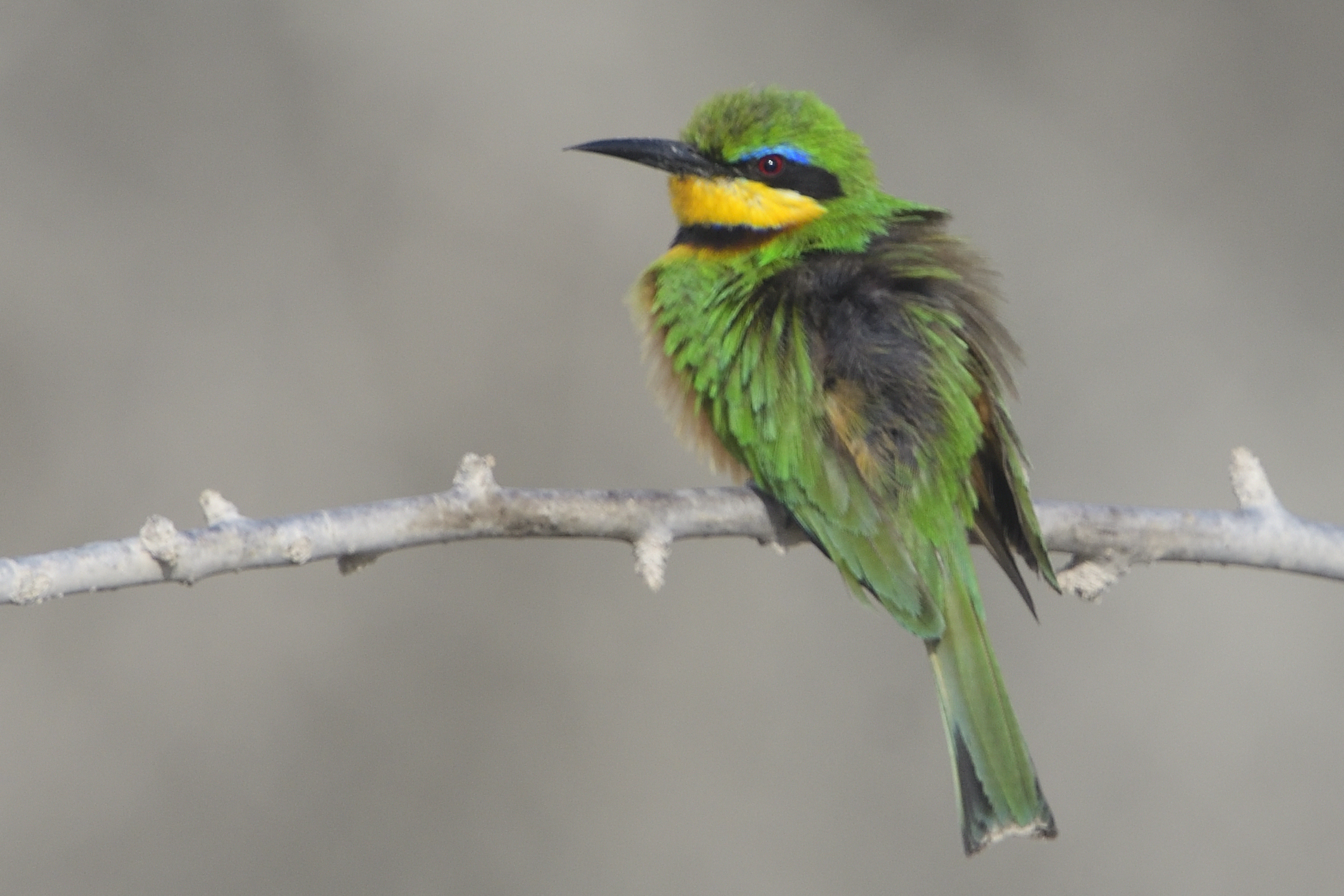
Little Bee-eater, Merops pusillus

Scaly Chatterer, Argya aylmeri, Endemic to NE Africa

Eastern Chanting Goshawk, melierax poliopterus, Endemic to NE Africa

Red-billed Oxpecker, Buphagus erythrorynchus

Red-tailed Shrike, Lanius phoenicuroides

Black-capped Social Weaver, Pseudonigrita cabanisi, Endemic to NE Africa

Black-necked Weaver, Ploceus nigricollis
Day 7, November 11 – Kiligolf – Same – South Pare Mountains
On that day, the safari began. We had dipped on two targets on the Masai Steppes the day before, Somali Bunting and Pringle´s Puffback. I had a backup site for those two birds in a scrubland just before Nyumba ya Mungu Dam. It is about a 2 1/2 hour drive from my home to that area. We found our two targets and here are some other birds observed: White-bellied and Southern Grosbeak Canary, Slate-colored Boubou, Sombre Greenbul, Bare-eyed Thrush, Black-throated Barbet, Blue-naped Mousebird, Pygmy Batis, Red-fronted Prinia and Black-faced Waxbill. We finished in the area at around 09:00 and I realized that we had time to go for a short visit to the Nyumba Ya Mungu dam itself. The primary target bird there were African Skimmer. On the way from the scrubland to the dam, we added Von der Decken´s Hornbill, Golden-breasted Starling and Pygmy Falcon to our list. At the dam we found a nice flock of very skittish African Skimmers in addition to the normal waterbirds like Spur-winged Lapwing, Great White Pelican, Grey-headed Gull, Whiskered Tern, Reed Cormorant, African Fish Eagle, Yellow-billed Stork, Black-headed and Grey Heron, Little Grebe, Pied Kingfisher, Kittlitz´s and Three-banded Plover, African Openbill, Ruff, Common Greenshank, Glossy Ibis and Common, Curlew, Marsh and Wood Sandpiper. We finished with the dam and drove towards Same and Elephant motel where we were staying for the night. On the way to Same we found amongst others, these birds: Brown-crowned Tchagra, Rosy-patched Bushshrike, Wattled Starling, and White-bellied Go-away-bird. We still had a little time before lunch when we reached Same and took us time to bird a little area just outside Mkomazi National Park. Here are some of the birds we registered in a scorching mid-day heat: Eastern Black-headed Batis and Black-bellied Sunbird, (those two were our primary targets in the area), Von der Decken´s Hornbill, Lizard Buzzard, Eastern Violet-backed Sunbird, Brubru, Long-tailed Fiscal, Red-tailed Shrike, Blue-naped Mousebird, Red-fronted Tinkerbird, Yellow-breasted Apalis and Black-necked Weaver. We drove to our motel had lunch and prepared for the afternoons adventure up South Pare Mountains. We left Elephant Motel at 15:00 sharp and were at our destination in South Pare at around 15:45 on quite interesting roads. It took us some time, but we discovered a huge flock of our target birds, South Pare White-eyes. Some of the other birds we registered included Bar-throated Apalis, Cinnamon-chested Bee-eater, Usambara Double-collared Sunbird, Black Saw-wing, Silvery-cheeked Hornbill, Evergreen Forest Warbler, East Coast Boubou, Black-fronted Bushshrike, Southern Citril, Cinnamon Bracken Warbler, Hartlaub´s Turaco, Striped-faced Greenbul, African Paradise Flycatcher, Augur Buzzard, African Yellow Warbler, Red-backed Mannikin, White-eared barbet, Singing Cisticola, Black Cuckooshrike and finally Trumpeter Hornbill. It was now 17:45 and I needed the 45 minutes to get back to the Motel before dark. We arrived at the Motel, ordered dinner freshened up and had dinner.
Some pictures from day 7:
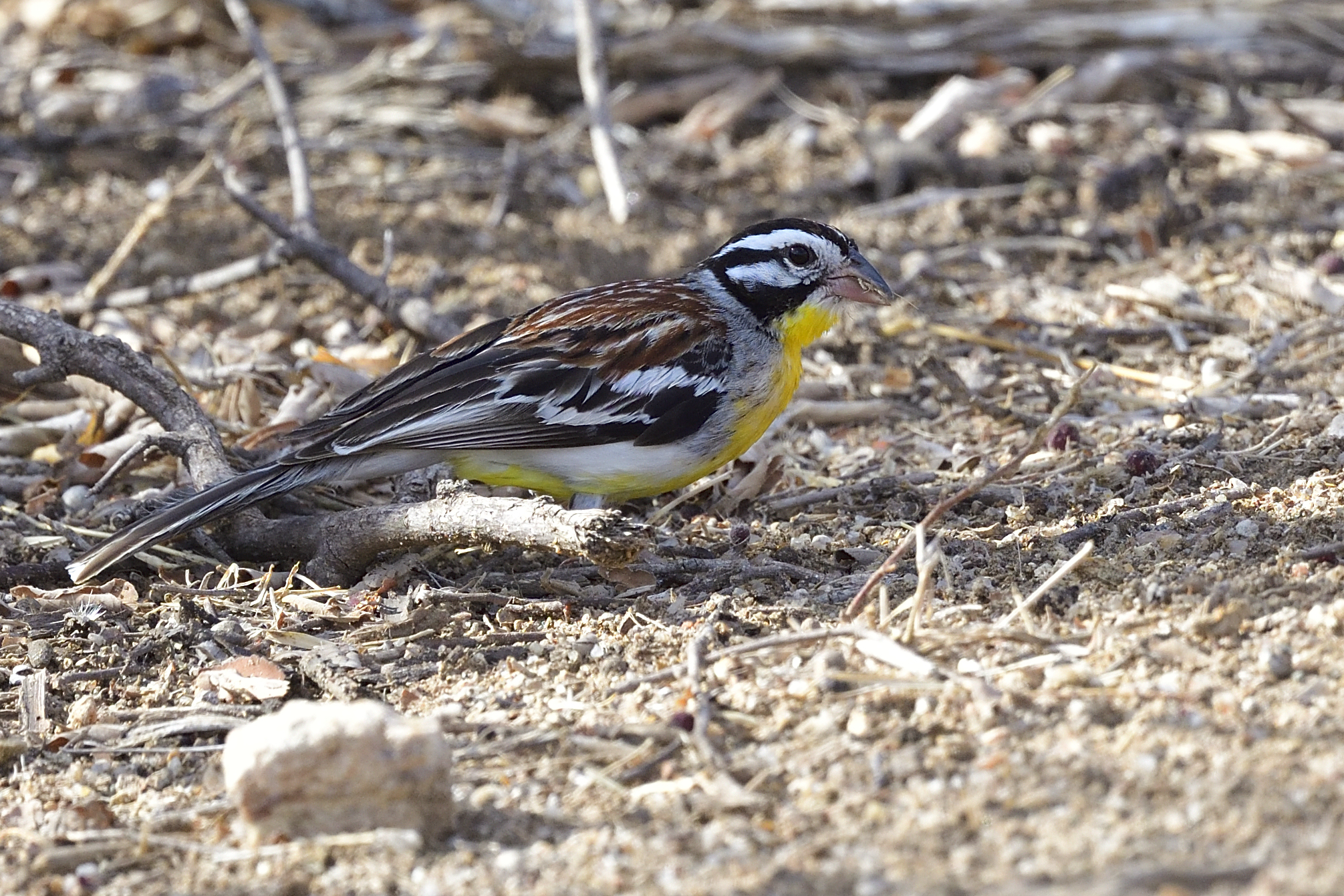
Somali Bunting, Emberiza poliopleura, Endemic to NE Africa

Black-bellied Sunbird, Cinnyris nectarinioides, Endemic to NE Africa

Von der Decken´s Hornbill, Tockus deckeni, Endemic to NE Africa
Day 8, November 12 – Same – Magamba Forest, West Usambara
We had both our targets in the Same area in box from the day before, but still decided to go back to the site in the beautiful morning light. Here are some of the new birds we recorded from the area that morning: Crested Francolin, Wahlberg´s Eagle, Eurasian Roller, Red-and-yellow, D´Arnaud´s, Spot-flanked and Black-throated Barbets, Greater Honeyguide, Red-bellied Parrot, Nubian Woodpecker, White-crested Helmetshrike, Chin-spot Batis, Orange-breasted Bushshrike, Pink-breasted Lark, Red-faced Crombec, Grey Wren-Warbler, Tiny Cisticola, Sombre Greenbul, Northern Brownbul, Pale White-eye, Bare-eyed Thrush, Spotted Palm Thrush, Eastern Violet-backed, Hunter´s and Tsavo Sunbirds, Southern Red Bishop, Purple Grenadier, Red-cheeked Cordonbleu, Yellow-spotted Bush Sparrow, Reichenow´s Seedeater and Southern Grosbeak Canary. We returned to the motel, ordered breakfast, packed the car, had breakfast and were on our way to West Usambara. There is 116 km with good roads from Same to Mombo, then about 60 km from Mombo to Magamba Forest on an interesting road that the Germans built before WW1. We stopped in Sono for supplies and then had another stop on the way close to a police control post. Here we recorded East Coast Boubou, Eastern Golden Weaver and Grey Olive Greenbul. We arrived in camp around 14:00. Set up camp and went for an afternoon birdwalk. Here are some of the birds we registered that afternoon: Southern Citril, Cinnamon-chested Bee-eater, Stripe-faced Greenbul, Hartlaub´s Turaco, Fülleborn´s Boubou, Eastern Bronxe-naped Pigeon, Moustached Tinkerbird, White-chested Alethe, Baglafecht Weaver, Evergreen Forest Warbler, Mountain Greenbul, Red-capped Forest Warbler, Usambara Akalat, Usambara Thrush, White-starred Robin, Cape Robin-Chat, Southern Yellow White-eye, Tambourine Dove, Cinnamon Bracken Warbler, Shelley´s Greenbul, Kenrick´s Starling, White-tailed Crested Flycatcher, African Olive Pigeon, Usambara Weaver, Usambara Double-collared Sunbird, Grey Cuckooshrike, Green Barbet, Yellow-throated Woodland Warbler and Placid Greenbul. What a fantastic afternoon where we got most of the West Usambara specials. Very bad views of the Akalat though so we still had work to do the coming days. I made dinner, we had a bone fire and retired early to our tents.
Some pictures from Day 8:
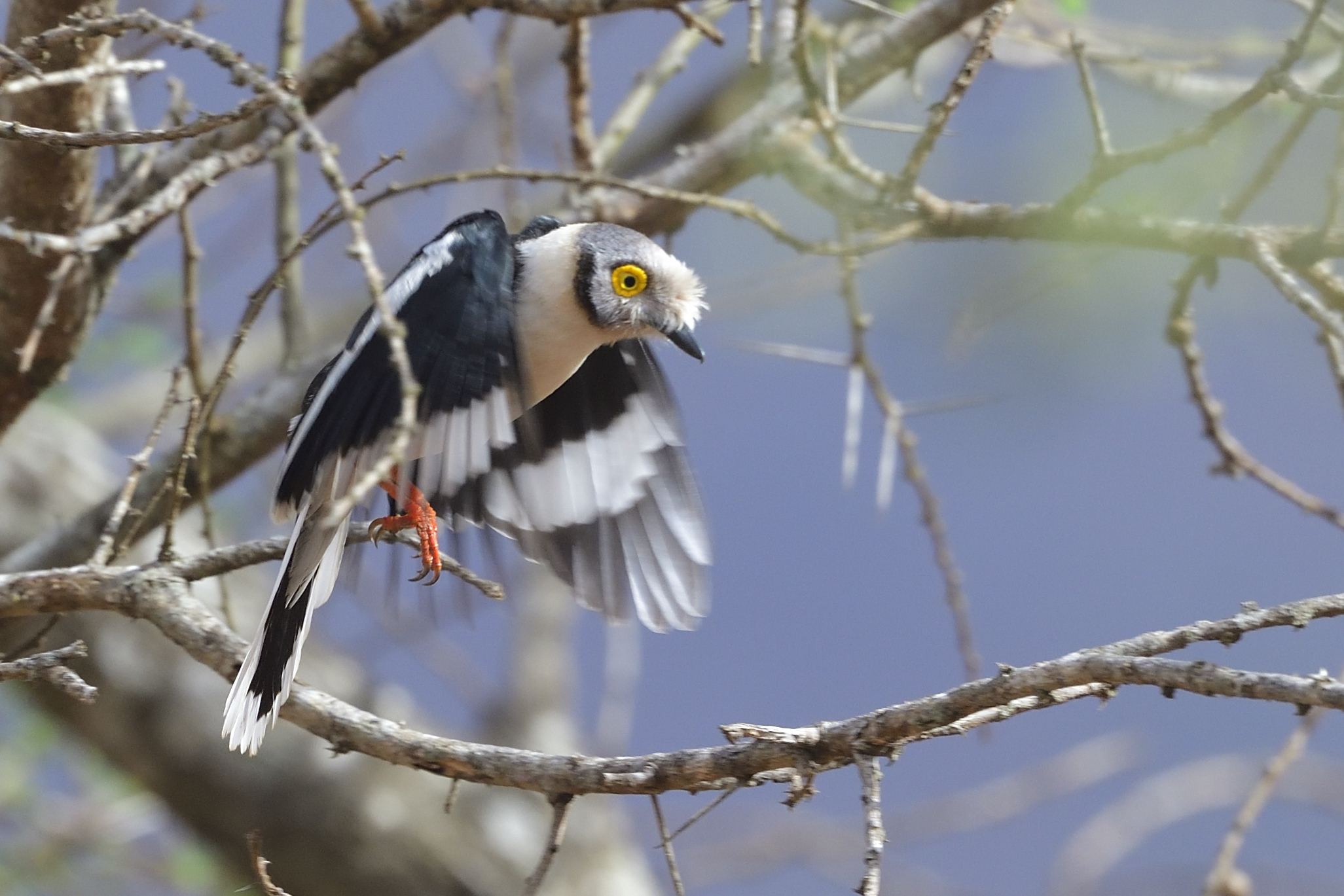
White-crested Helmetshrike, Prionops plumatus

Tsavo Sunbird, Cinnyris tsavonensis, Endemic to East Africa
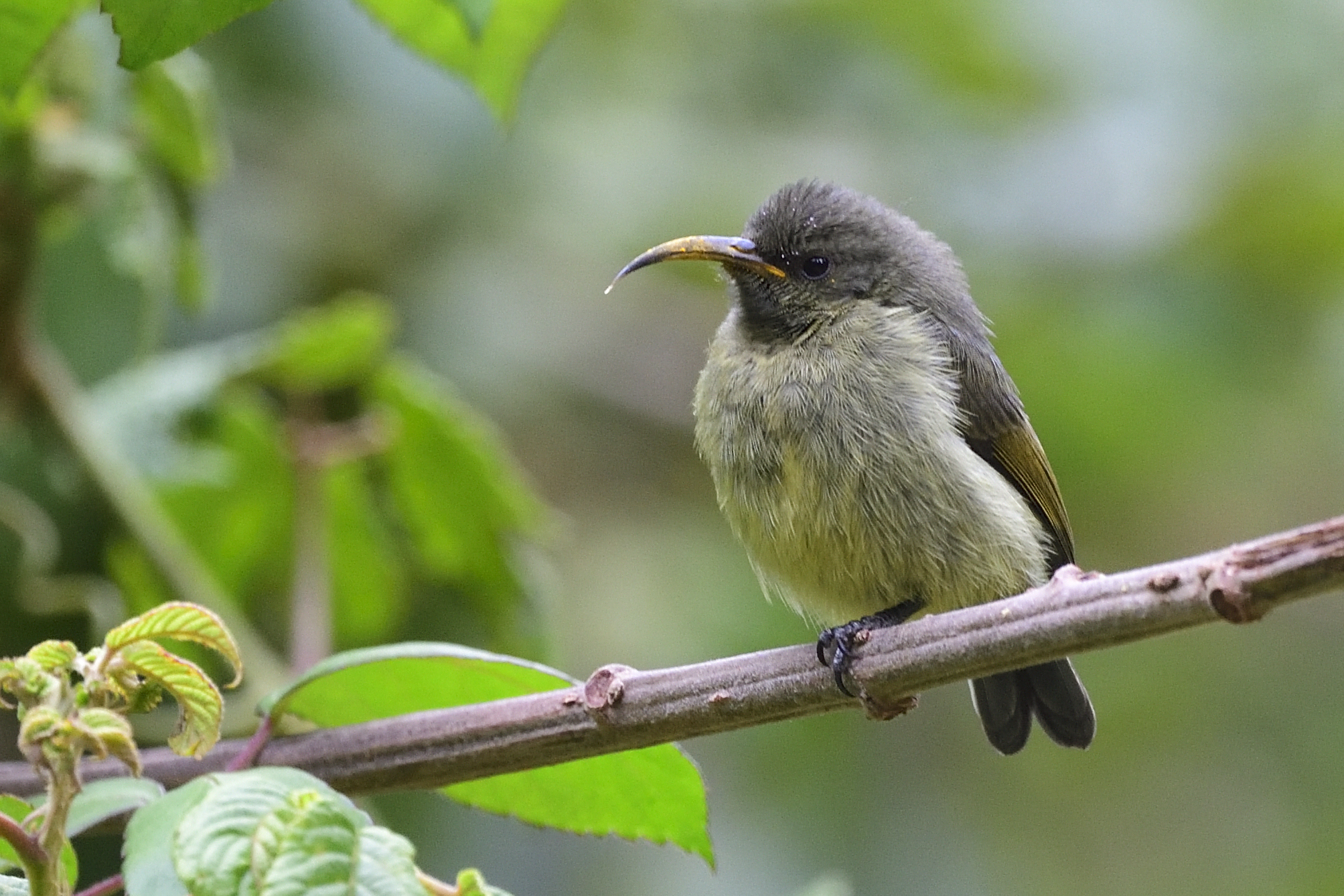
Usambara Double-collared Sunbird (Female), Cinnyris usambaricus, Endemic to South Pare and Usambara Mountains in Tanzania

Usambara Double-collared Sunbird, Cinnyris usambaricus, Endemic to South Pare and Usambara Mountains in Tanzania

usambara Thrush, Turdus roehli, Endemic to Usambara and Pare Mountans, Tanzania

Usambara Weaver, Ploceus nicolli, Endemic to Eastern Arc Mountains of Tanzania
Day 9, November 13 – Magamba Forest
We had a full day in Magamba Forest that day. We saw many of the same birds as the day before, but also added a few. In the morning we walked up from camp again and had nice views of White-chested Alethe. Some of the other new birds from Magamba Forest that morning included: Olive Sunbird, Waller´s Starling, Black-fronted Bushshrike, African Goshawk, African Black Duck, African Dusky Flycatcher, African Stonechat, Baglafecht Weaver, Red-faced Crimsonwing, Silvery-cheeked Hornbill, Sharpe´s Starling, Bar-throated Apalis, African Hill Babbler, Bar-tailed Trogon and Olive Woodpecker. We returned to camp at 10:00 and I made breakfast. After breakfast, I decided to try a new path where I have had good spotting of Usambara Akalat and Spot-throat before. We heard the Spot-throat and decided to sit and wait for it to show. We had glimpses, but not very good. After a while Ray got a little restless, so we decided to split up. Nick and Isaac (guide) were supposed to sit and wait out the Spot-throat while Ray and me were supposed to explore the road below camp. I needed some calls form Isaac and while I was recording the Usambara Akalat off Isaac´s phone, the bird decided to come in and check. We all had very good views. We heard another Spot-throat calling and moved to locate it. We had better views now. Ray and I said farewell to the other two and went back towards camp. Just a 100 meters from camp, we were hit by a mighty rainfall. Nothing to do than ride the storm out under the roof of the old sawmill where we keep our tents. The other two were still in the forest and came into camp about half an hour later like drowned cats. The rain lasted for a while and the only new birds for Magamba we registered that afternoon were Mountain Buzzard, Placid Greenbul, Southern Citril and African Wood Owl. We returned to camp, I made dinner again. We sat some time around the fire before we went early to bed.
Some pictures from Day 9:

White-chested Alethe, Chamaetylas fuelleborni, Endemic to SE Africa

Southern Citril, Chritagra hyposticta, Endemic to SE Africa

(Black-headed) Mountain Greenbul, Arizelocichla nigriceps, Endemic to highland forests of N Tanzania and S Kenya

Isaac, Ray and Nick staking out the Spot-throat.

Cape Robin-Chat, Cossypha caffra
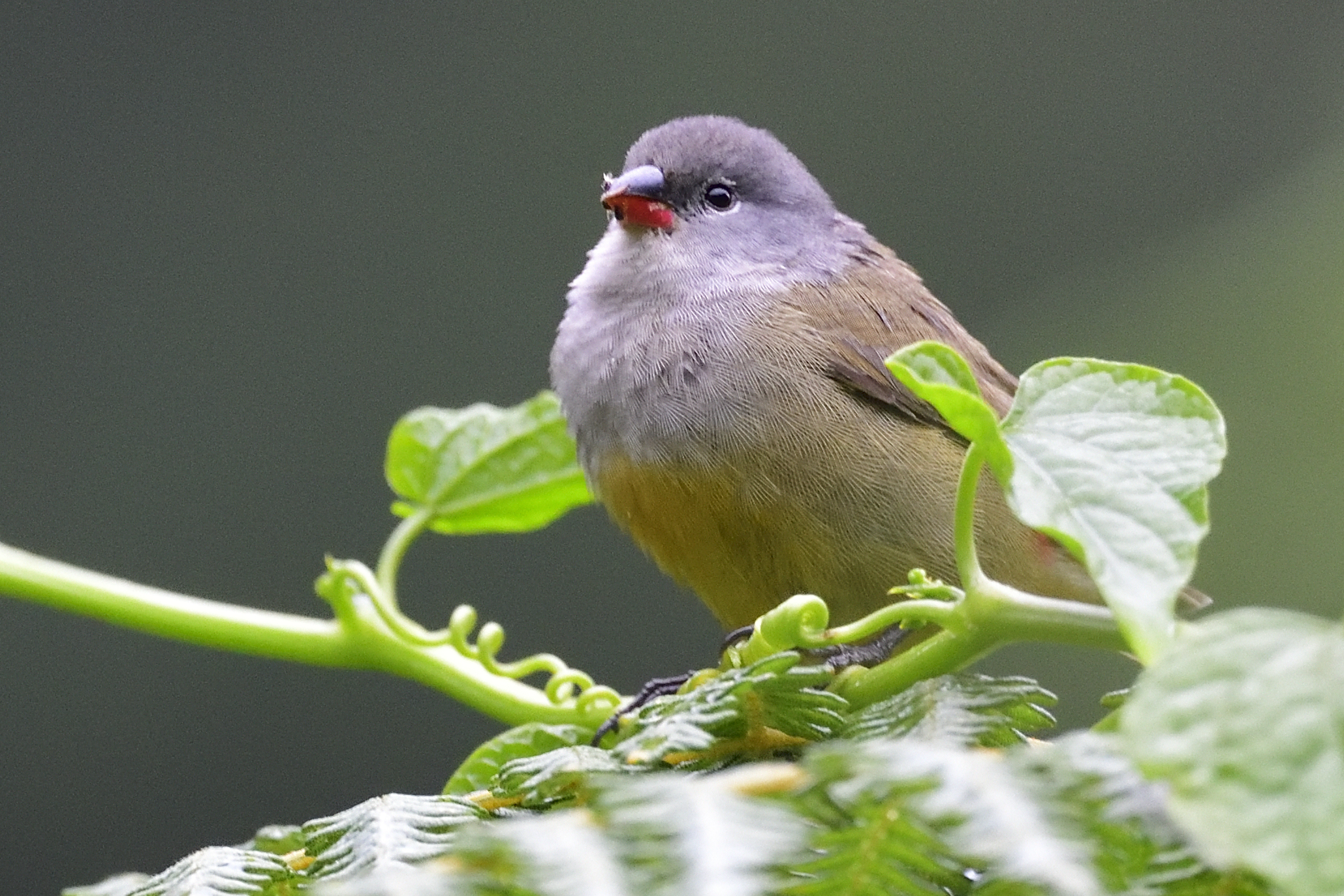
Yellow-bellied Waxbill, Coccopygia quarantina
Day 10, November 14 – Magamba Forest – Amani Forest East Usambara
On that day we were supposed to do morning birding in Magamba Forest, West Usambara and drive to Amani Forest in East Usambara after breakfast. Normally I would have walked down from camp on this morning, but my friends were more interested in getting a possible picture of a Spot-throat. On the way to the spot, we saw an Oriole Finch feeding a young one. The only other new bird we added to the list this morning was Grey Wagtail. We returned to camp, I made breakfast, packed and were soon underway. We decended the mountain and drove towards Segera, were we turned towards Muheza. From Muheza, we drove towards Amani Forest. We made a short stop just a few km north of Muheza to get the Coastal Cisticola. After bagging that, we continued to the lower forest of Amani. It was very hot and no activity so we decided to go straight to camp. We were out for a short bird walk around the research station at around 15:30. Here are some of the birds we registered: Silvery-cheeked Hornbill, Green Barbet, Olive Sunbird, Red-backed Mannikin, White-eared Barbet, African Harrier-Hawk, East Coast Boubou, Pale Batis, Collared and Purple-banded Sunbird, African Green Pigeon, Grey Cuckooshrike, Spectacled Weaver, Palm-nut Vulture, Black-bellied Starling, Crowned Eagle, Black-and-white Shrike-Flycatcher and Red-capped Robin-Chat. We returned to camp. I told my friends that the Olive Ibis might fly over at dusk. Raymond listened to me and we saw a few of them fly over. We freshened up, had dinner and retired early to bed.
Some pictures from Day 10:

Oriole Finch (juvenile), Linurgus olivaceus

African Harrier-Hawk, Polyboroides typus
Day 11, November 15 – Amani Forest
Full day in Amani Forest. We had an early start and drove up quite a bit to the place we normally find Kretchmer´s Longbill and Long-billed Forest Warbler. From experience I knew we were a little early, but I also knew there were other interesting birds in the area. I took my friends for a little walk and at the end of the walk we found Several Fischer´s Turacos, closely followed by several Green-headed Orioles. Other new birds for Amani included Little Greenbul, White-browed Coucal , Common Square-tailed Drongo and Common Waxbill. On the way back to the hotspot for the Longbill, it started singing. We had several good sightings, but alas no pictures. Our next target Long-billed Forest Warbler proved harder to find, but in the end we all got good views. Some of the other birds registered in the area were Dark-backed and Spectackled Weaver, Cabaisis´s Bunting, Uluguru Violet-backed Sunbird, Eastern Nicator, Moustached Tinkerbird and Black-fronted Bushshrike. With our 2 prime targets in box, it was time to move on to target number 3, Sharpe´s Akalat. It took us some searching, but we finally had good views of the Akalat. Other birds in the area included Placid Greenbul, African Goshawk, Mountain Greenbul and Lemon Dove. We had 3 out of 3 targets for the morning so now it was time to look for number 4, Half-collared Kingfisher. I stopped at our normal spot and we walked next to the river until we spotted one of them. With all 4 targets in box, we decided to return back to camp for lunch. On the way, we picked up Brown-hooded Kingfisher, Blue-spotted Wood Dove and Long-crested Eagle. We were back in camp for lunch and were out birding again around the Amani forest station at around 15:00. We still had some target birds to find in that area. We added Shelley´s Greenbul, Lesser Striped Swallow, Red-backed Shrike, Grey Wagtail, Rock Martin, Banded Green Sunbird, Kenrick´s Starling, Ayre´s Hawk-Eagle, Yellow-streaked Greenbul, Trumpeter Hornbill and White-chested Alethe to our Amani list + some more common birds. We sat out at dusk and waited for the Olive Ibis to pass, but they did not show that afternoon. We freshened up, had dinner and retired early to bed.
Some pictures from Day 11:

Long-crested Eagle, Lophaetus occipitalis

Purple-banded Sunbird, Cinnyris bifasciatus

Me, Ray and Nick waiting for the Olive Ibis.
Day 12, November 16 – Amani Forest
Another full day in Amani Forest. That morning we drove down to the lower section of the forest. We walked up a path to get away from the noise from the main road. Here are some of the birds we observed: Little Yellow Flycatcher, Green-headed Oriole, Red-tailed Ant-Thrush, Tanzanian Illadopsis, Fischer´s Greenbul, Narina Trogon, Forest Batis, Grey-headed Kingfisher, Usambara Hyliota, Amani Sunbird, African Broadbill, Lowland Tiny Greenbul, Klaas´s Cuckoo, Green Malkoha, Bar-throated Apalis, Long-crested Eagle, Yellow-streaked Greenbul, Eurasian Golden Oriole, Moustached Tinkerbird, Grey Tit-Flycatcher and Dark-backed Weaver. We returned to camp for lunch. After lunch, we decided to take a path up from camp. This path proved as before very unproductive. We also tried to drive up to Emau Hill Camp for Nick and Ray to get better views of the Cabanis´s Bunting. Still no luck. We did not add any new birds before at dusk, Nick also saw the Olive Ibis and after dinner when we could add Usambara Eagle-Owl and African Wood-Owl to our list.
Some pictures from Day 12:

Forest Batis, Batis mixta, Endemic to coastal East Africa

Forest Batis (Female), Batis mixta, Endemic to coastal East Africa

African Broadbill, Smithornis capensis

Grey Tit-Flycatcher, Myioparus plumbeus – TZ Photo lifer for me

Lowland Tiny Greenbul, Phyllastrephus debilis, Endemic to coastal SE Africa

Dark-backed Weaver, Ploceus bicolor
Day 13, November 17 – Amani Forest – Kiligolf
The last day of the Safari before we returned to my home on Kiligolf. We har ordered packed breakfast and started the morning by going to the lower forest again. We arrived at around 07:00 and took the path up from the main road. We added a few new species like Red-throated Twinspot and Green Tinkerbird. We returned to the main road and walked downhill. We discovered a Blue-mantled Crested Flycatcher, that proved very hard to get a picture off. Other new birds added for Amani included Little Spotted Woodpecker, Chestnut-fronted Helmetshrike, Plain-backed Sunbird, Palm-nut Vulture and Black-headed Apalis. We had now reached the lower part of the forest and climbed into the car and set out for the long drive back home. We arrived in good time before darkness. Again, Selvine and Neema had prepared a nice meal for us. We had dinner, went through the bird list (as we had been doing every night) and retired early to bed.
Some pictures from Day 13:
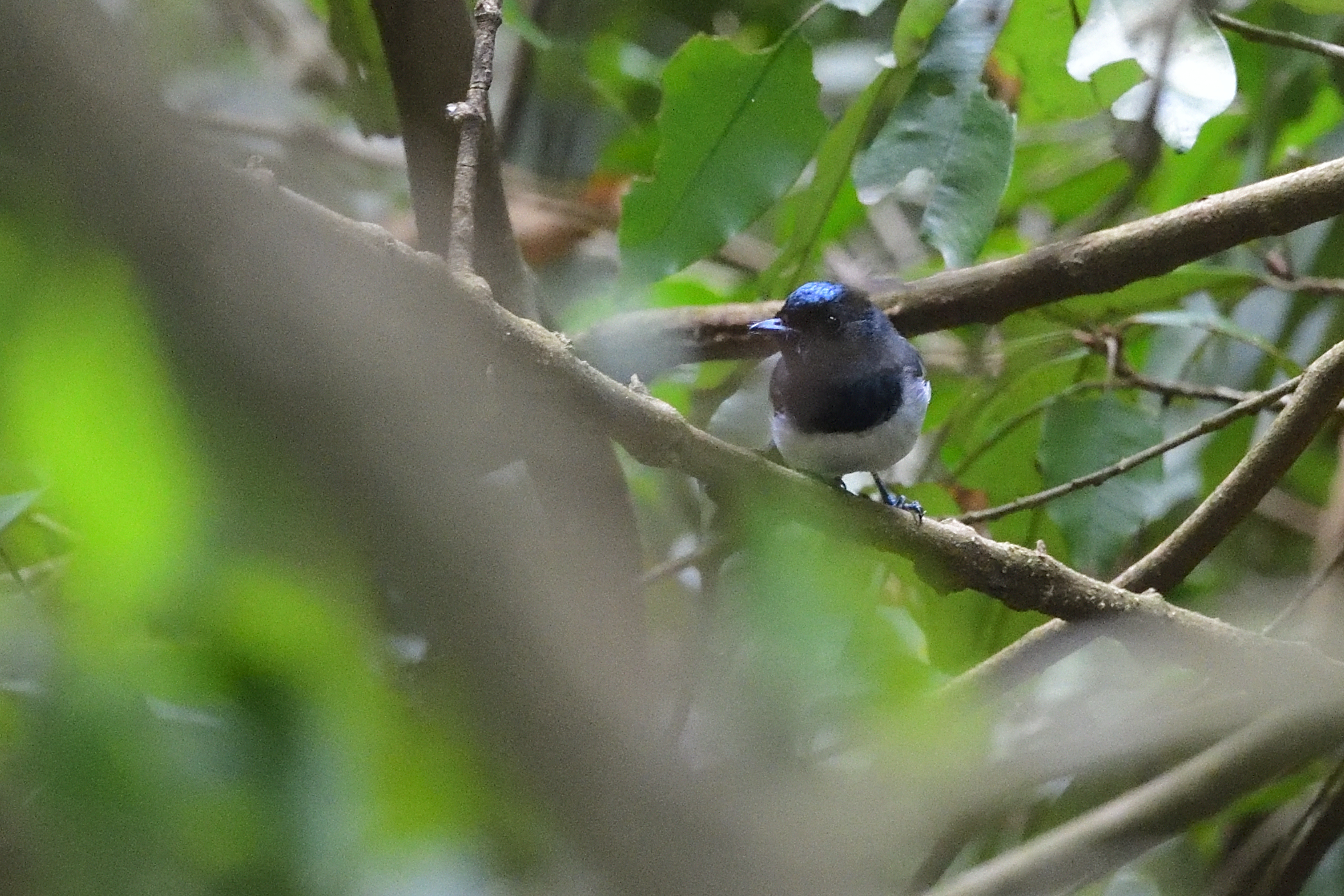
Blue-mantled Crested Flycatcher, Trochocercus cyanomelas – A photo lifer for me in East Africa including Tanzania

Chestnut-fronted Helmetshrike, Prionops scopifrons

Palm-nut Vulture, Gypohierax angolensis
Day 14, November 18 – Arusha National Park
Arusha National Park is located only about a half an hour drive from my home, so after the long drive the day before, it was nice to have a short distance to travel to the gate that morning. The Park opens at 06:30, but there are rarely anyone to issue tickets there at that time. We arrived at 07:00 and still no people in the office. Isaac took my friends birding around the gate while I negotiated to let us in and pay on our way out. Some of the birds registered at the gate included: Singing Cisticola, Tropical Boubou, Northern Grey-headed Sparrow, African Yellow Warbler, Cape Robin-Chat, Northern Fiscal and Horus Swift. After being allowed in to the park without having paid we climbed in to the car and started our drive. Our first stop were as always at the museum. Some of the birds we picked up before the museum included: Golden-backed Weaver, Southern Citril, Tambourine Dove, Trilling Cisticola, Rüppel´s Robin-Chat, Grey-crowned Crane, Silvery-cheeked Hornbill and European Honey Buzzard. We stopped at the museum to stretch our legs, but it was very quiet. We continued up to to our breakfast site at the Eastern fork of the Ngurdoto Crater Rim. On our way we picked up these species. Retz´s Helmetshrike, Black-headed Apalis Eastern Grey Woodpecker, Broad-ringed White-eye, Eurasian Blackcap, Golden-tailed Woodpecker, Scarce Swift, Black-headed Oriole, Black-fronted Bushshrike, African Goshawk, Stripe-faced Greenbul, African Black Swift, Forest Batis and White-eyed Slaty Flycatcher. At the picnic site, there had been a nesting pair of Abbott´s Starling for a long time, but on that day they were gone. The picnic site provides a magnificent view over the crater floor. We enjoyed our breakfast and was ready to roll again at around 10:00. We drove down to the fork and took the other route up the crater rim. It was very quiet and the Scaly Spurfowls were no where to be found. We even got up to the viewpoint which is normally good for Swifts and Swallows, but very quiet. We returned to the car and drove down back to the museum. From there, we went a little faster through the forest and stopped at a normally very productive wetland, but it was completely dried up. We were heading for the Momela lakes and on the way to the lakes after the forest we added amongst others these species to our Arusha NP list: Olive Sunbird, Grey-headed Kingfisher, Long Crested Eagle, African Stonechat, African Paradise Flycatcher, Rufous-naped Lark, Northern Fiscal and Yellow Bishop. We arrived at the Lakes and started our loop around the lakes. Here are some of the birds we picked up: Southern Pochard, Little Grebe, Marsh Sandpiper, Black-winged Stilt, Ruff, Cape Teal, Spur-winged Lapwing, White-browed Coucal, Trilling, Red-faced and Winding Cisticola, Crimson-rumped Waxbill, Pied Avocet, Pangani Longclaw, Little Stint and Curlew Sandpiper. We had now reached the new picnic spot in the park and we spotted a few Maccoa Ducks. We left the picnic spot and continued. Here are some of the other birds we registered: Martial Eagle, Greater and Lesser Flamingo, Buff-bellied Warbler, Alpine Swift, Red-billed Teal, African Fish Eagle, White-browed Scrub-Robin, Vitelline Masked and Spectacled Weaver and Long-billed Pipit. We had been using the White Landy on our Safari and now we were using the Green Landy. I asked my Fundi (mechanic) if he had fixed the fuel gauge. He confirmed he had. He had been overhauling the Green Landy when we were at the safari. When I stopped for the Flamingos, I realised something was wrong. After a few more km, we actually ran out of Diesel even though the fuel gauge showed the tank was 3 quarters full. I checked my phone and I had no signal. Isaac sacrificed himself and climbed to the top of a hill where he managed to get hold of my Fundi. We lost a good hour at the roadside waiting for Diesel to arrive it was 13:00 so we enjoyed packed lunch inside the car. We were only a few km from the picnic site we should have had lunch, so all in all no major harm done except to my pride. My Fundi arrived and we managed to refill diesel and continue the trip. Here are some of the other birds we picked up on our circuit of the lakes: Orange-breasted Bushshrike, European Bee-eater, Common Ringed Plover, Common Sandpiper, Thick-billed Weaver, African Hawk-Eagle, Brown-headed Kingfisher, Short-winged Cisticola, Moustached Grass Warbler, Nubian Woodpecker, African Spoonbill, Intermediate Egret, Common Nightingale and Baglafecht Weaver. We had now completed the circuit and headed towards Mount Meru. We stopped for some mammals at a grassland and I rediscovered the albino Baboon that has been present in Arusha NP for a while. At he Momella gate, I paid our entry fees. We drove as far up Mount Meru as to the waterfall on very questionable roads. On the way up and down the mountain, we added amongst other species Cinnamon-chested Bee-eater, Hartlaub´s Turaco, Placid Greenbul, Broad-ringed White-eye, African Dusky Flycatcher, Cinnamon-bracken Warbler, Red-fronted Parrot, Silvery-cheeked Hornbill, Eastern Bronze-naped Pigeon, White-starred Robin, Mountain Greenbul, Oriole Finch, African Olive Pigeon, Brown Woodland Warbler and Lemon Dove. We were down the mountain at around 18:00 and had to drive faster on very bad roads to be out of the park before closing time at 18:30 We arrived at the gate at 18:29. Drove the short way home, freshened up and had again a nice dinner prepared by the ladies.
Here are some of the pictures from Day 14:

Albino Baboon

Trilling Cisticola, Cisticola woosnami
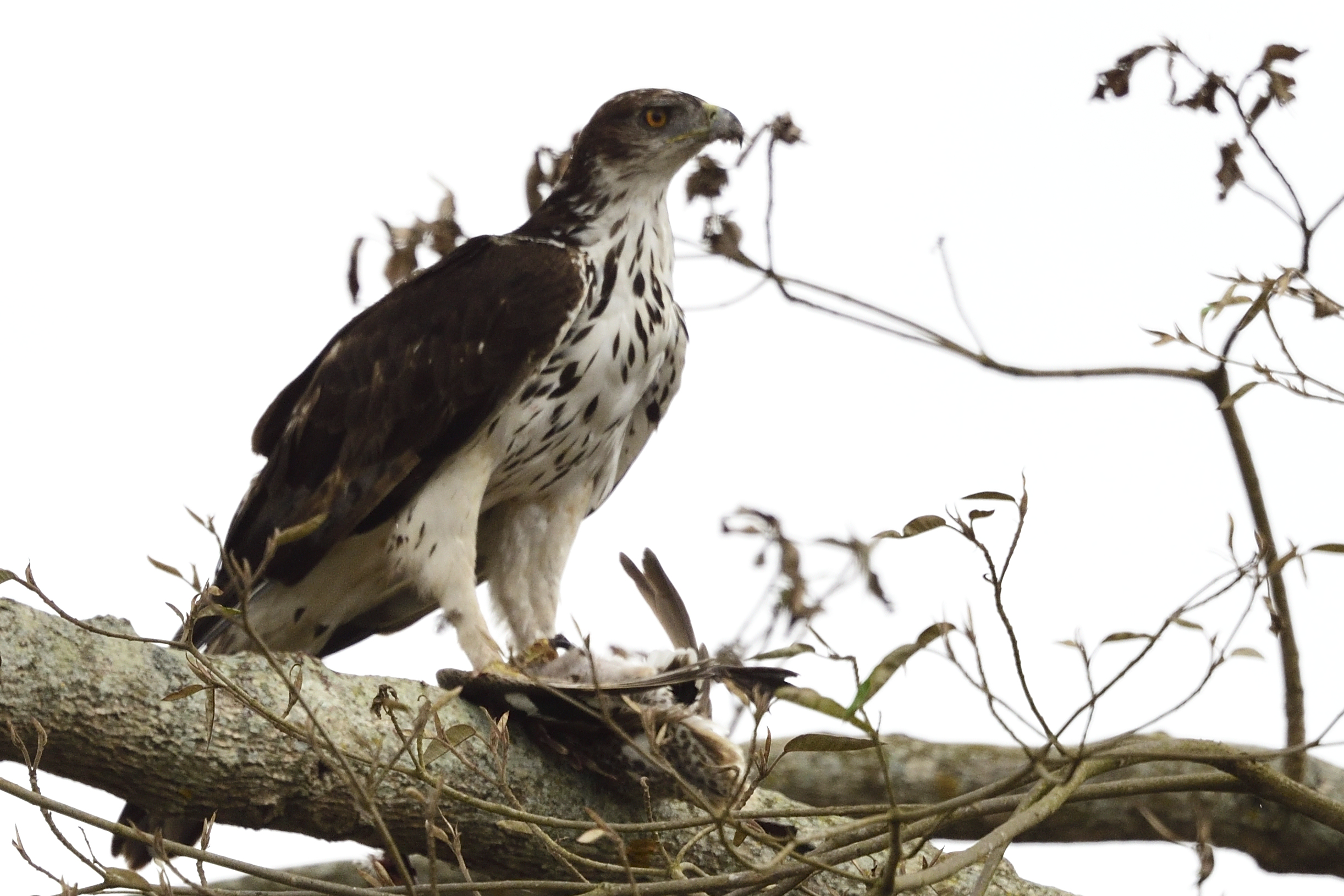
African Hawk-Egle, Aquila spilogaster with prey.

Greater Flamingo, Phoenicopterus roseus

Lesser Flamingo, Phoeniconaias minor

Moustached Grass Warbler, Melocichla mentalis
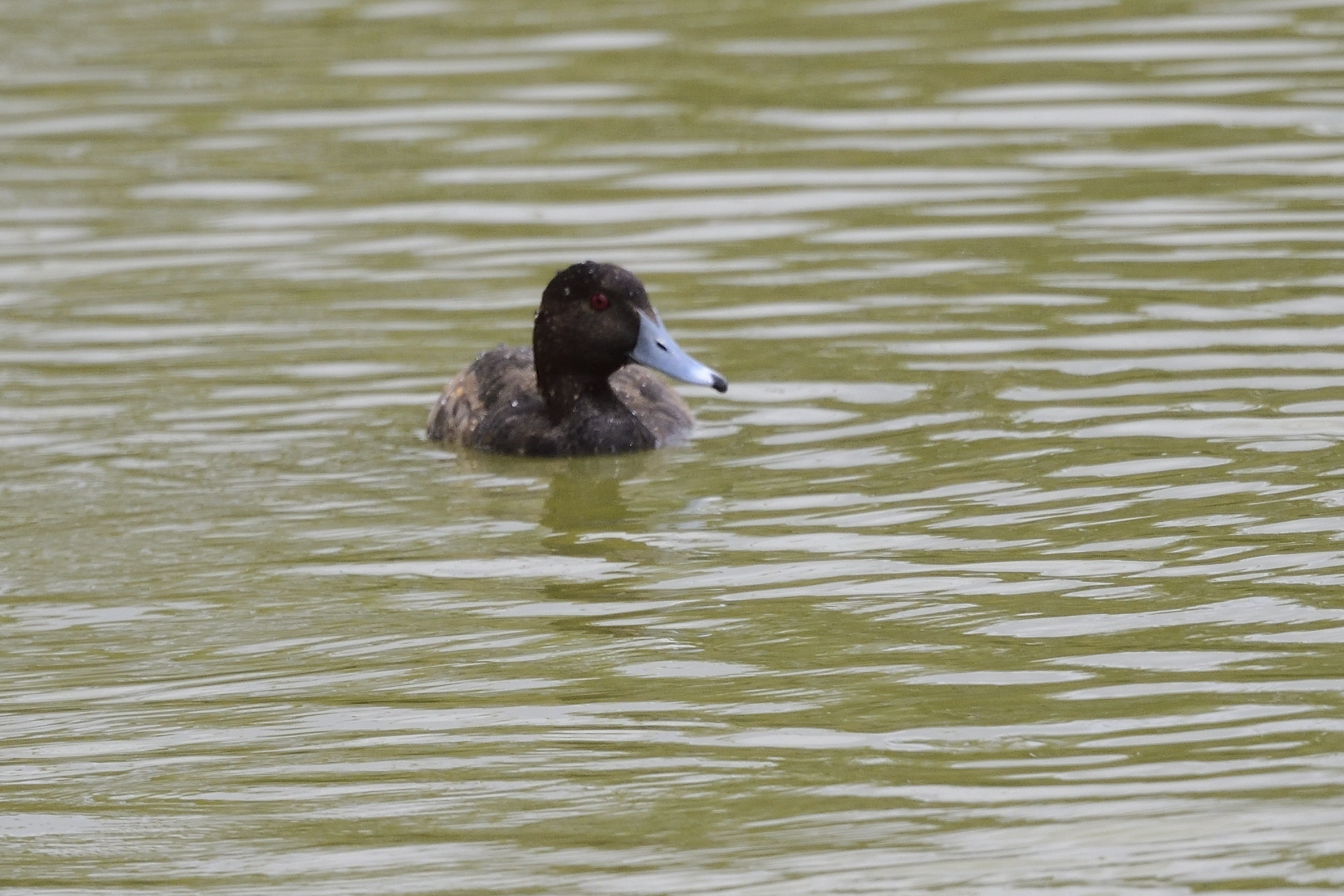
Southern Pochard, Netta erythrophthalma

Marsh Sandpiper, Tringa stagnatilis

African Dusky Flycatcher, Muscicapa adusta

Colobus Monkey, Obviously a male 🙂

Ray, me and Nick at the Waterfall on Mount Meru

Red-fronted Parrot, Poicephalus gulielmi
Day 15, November 19 – Ngarasero Lodge, Meru Forest and Kalanga Forest
On that day we were also doing some close to home birding. The first stop were at Ngarasero Lodge where a Malagasy Pond Heron had been located for a few months. Unfortunately it had left when we arrived. Here are some of the other birds we observed: African Palm Swift, Common Moorhen, Little Greenbul, African Jacana, African Black Duck, Little Grebe, Taveta Weaver, African Jacana, Grey Olive Greenbul, Grey-backed Camaroptera, Collared Sunbird, Tropical Boubou, Red-throated Twinspot, Lemon Dove, Rüppel´s Robin-Chat, Black-throated Wattle-eye, African Pygmy Kingfisher, Black-backed Puffback, Reed Cormorant, Striated Heron, African Fish Eagle and African Goshawk. Our next destination were Meru Forest. We stopped at a petrol station and topped up the Diesel. We had fantastic views of a flock of Village Weavers. The next stop before Meru Forest were a breading colony of Speke´s Weaver. I followed Isaac´s instructions to get to the entrance to Meru forest only to realise that he had never been there before. I had to scramble my brain and eventually we arrived there. We stopped a little before the forest to try for Tacazze Sunbird, but we only managed Bronzy Sunbird. At the forest entrance, there were a good number of Hunter´s Cisticolas, Just after the first climb we finally managed a female Tacazze Sunbird, no sign of the male. We continued up the slopes and connected with a pair of Yellow-crowned Canaries shortly followed by a confiding Thick-billed Seedeater. Then Isaac spotted an Abyssinian Crimsonwing at the bottom of a small river valley. We continued up and had several nice views of Abbott´s Starling. Other birds on the way up included Harlaub´s Turaco, Mountain Buzzard, Narina and Bar-tailed Trogon (only I saw the Bar-tailed because I was a little ahead of the others) I got them to the spot, but we could not entice it to come back. Cinnamon-chested Bee-eater, Red-fronted Tinkerbird, Black-fronted Bushshrike, Bar-throated and Black-headed Apalis, Evergreen and Cinnamon Bracken Warblers, Mountain and Placid Greenbul, Brown Woodland Warbler Broad-ringed White-eye, Rüppel´s Robin-Chat, White-starred Robin, Eastern Double-collared Sunbird and Southern Citril were some of the other birds we observed in Meru Forest. On the way down the mountain slope we were stopped by a ranger. I told the others to continue to the car. The ranger informed me that Meru Forest were part of Arusha National Park. I had been up there about 10 times and I asked the first guide I used if we went high enough, would we enter Arusha NP. He said no. In a way I felt totally innocent for trespassing. There are no signs. The ranger tried to get aggressive, but I calmed him down and gave him the number to the first guide that had taken me there. They had a conversation in Kiswahili and I was allowed to go towards my car. Just before I reached my car, the ranger caught up with me again and wanted money. I managed to negotiate a price I was comfortable with. It is nearly impossible to get a ticket to enter the forest and a lot of locals are using the path to collect firewood. It might be a scam? This is a forest used by many local birders so I issued a warning on the group Birding Tanzania on Facebook. I returned to the car and we went to a local restaurant in Usa River for lunch. Our last destination for the day were Kalanga or Choma Forest. Isaac had a spot for the Red-chested Flufftail, but we never managed to even hear it. The same happened in Kalanga forest, where we have a spot for Buff-spotted Flufftail. I believe those birds are seasonal inter african migrants and I am not sure when they show up. We did not add any new birds in Kalanga forest for the day so we returned back home a little early and my friends took some bird pictures in my garden.
Here are some pictures from Day 15:

African Black Duck, Anas sparsa

African Jacana, Actophilornis africanus

Village Weaver, Ploceus cucculatus
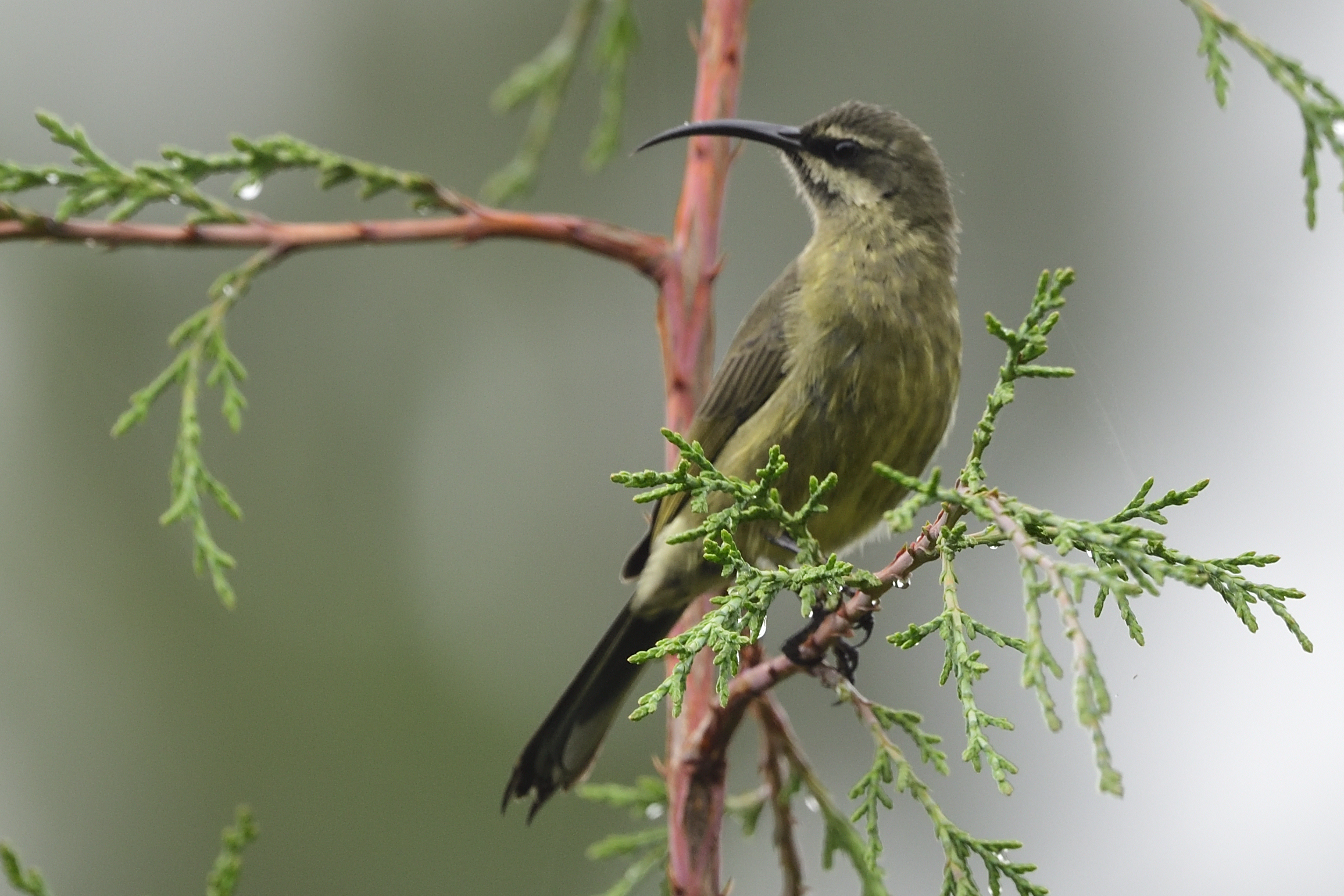
Tacazze Sunbird (female), Nectarina tacazze, Endemic to NE Africa
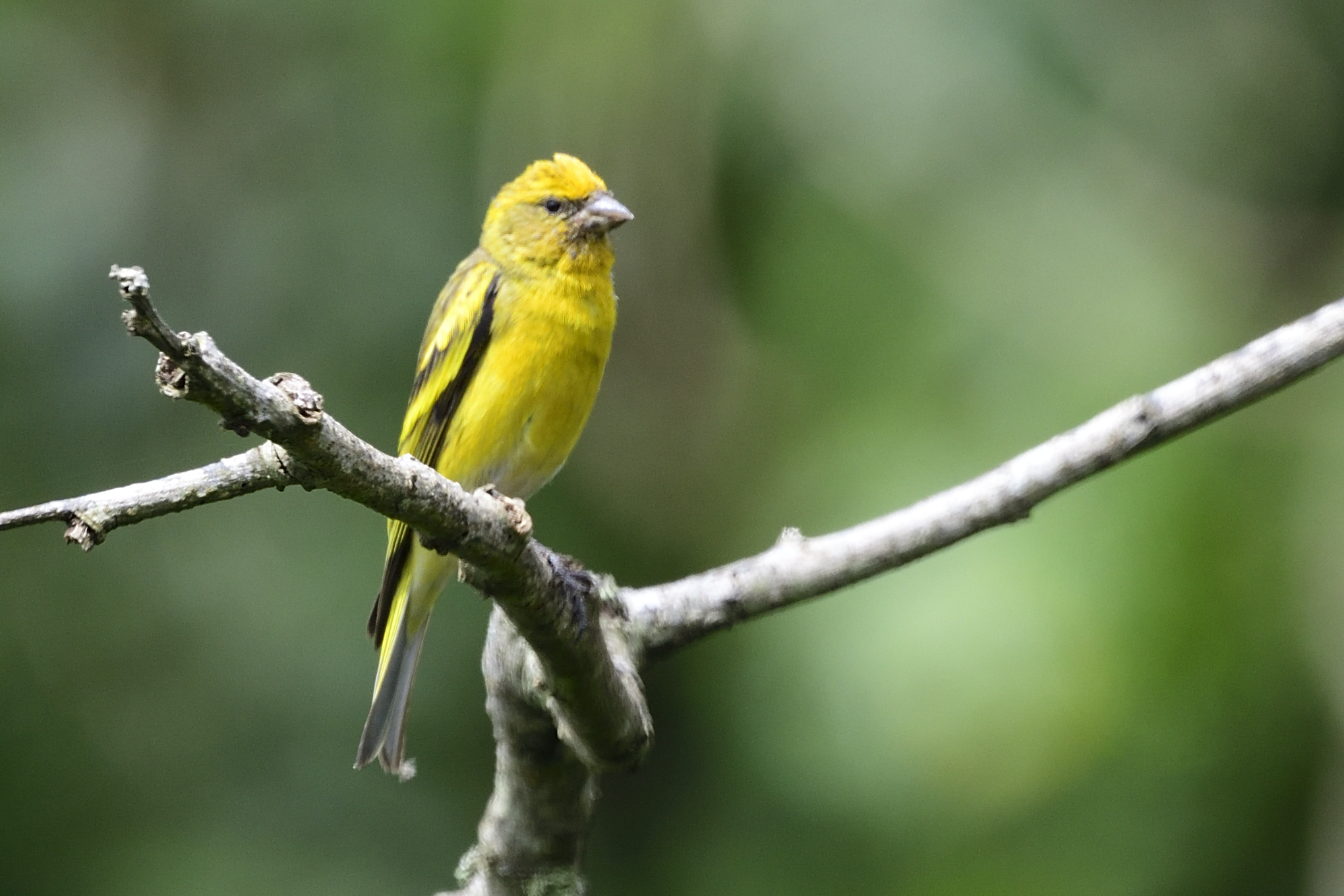
Yellow-crowned Canary, Serinus flavivertex

Yellow-crowned Canary (female), Serinus flavivertex

Abyssinian Crimsonwing, Cryptospiza salvadorii, Endemic to NE Africa

(Black-headed) Mountain Greenbul, Arizelocichla nigriceps, Endemic to highland Forests of N Tanzania and S Kenya

White-starred Robin, Pogonocichla stellata

Thick-billed Seedeater, Chritagra burtoni
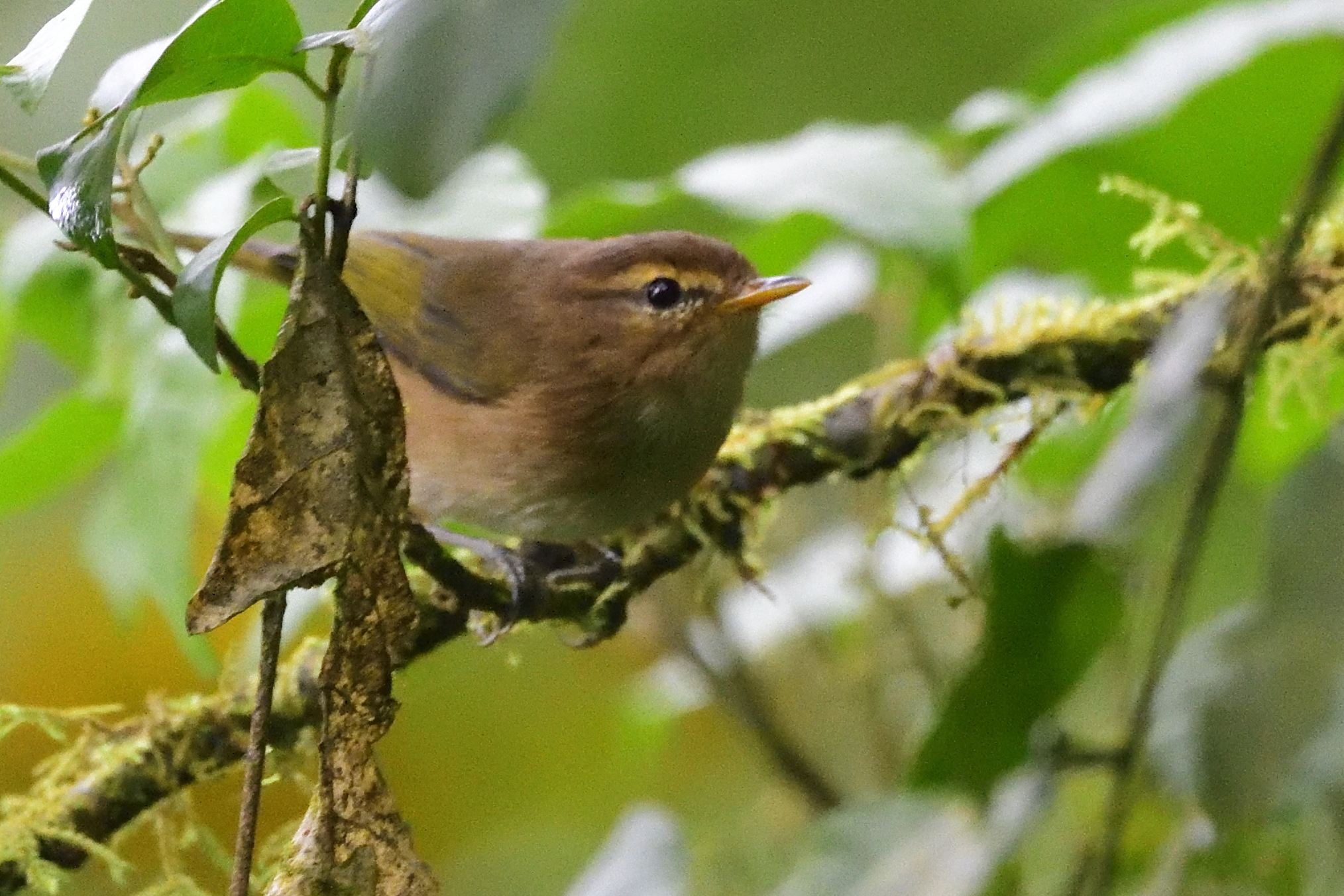
Brown Woodland Warbler, Phylloscopus umbrovirens, Endemic to NE Africa

Broad-ringed White-eye, Zosterops eurycricotus, Endemic to NE Tanzania
Day 16, November 20 – Kiligolf – Airport
The last day of the trip. My friends decided to just relax in the garden and take pictures from the comfort of my chairs. A rare visitor to my garden an Amethyst Sunbird posed nicely for me. We had lunch and I took my friends to the airport.
Some pictures from Day 15:
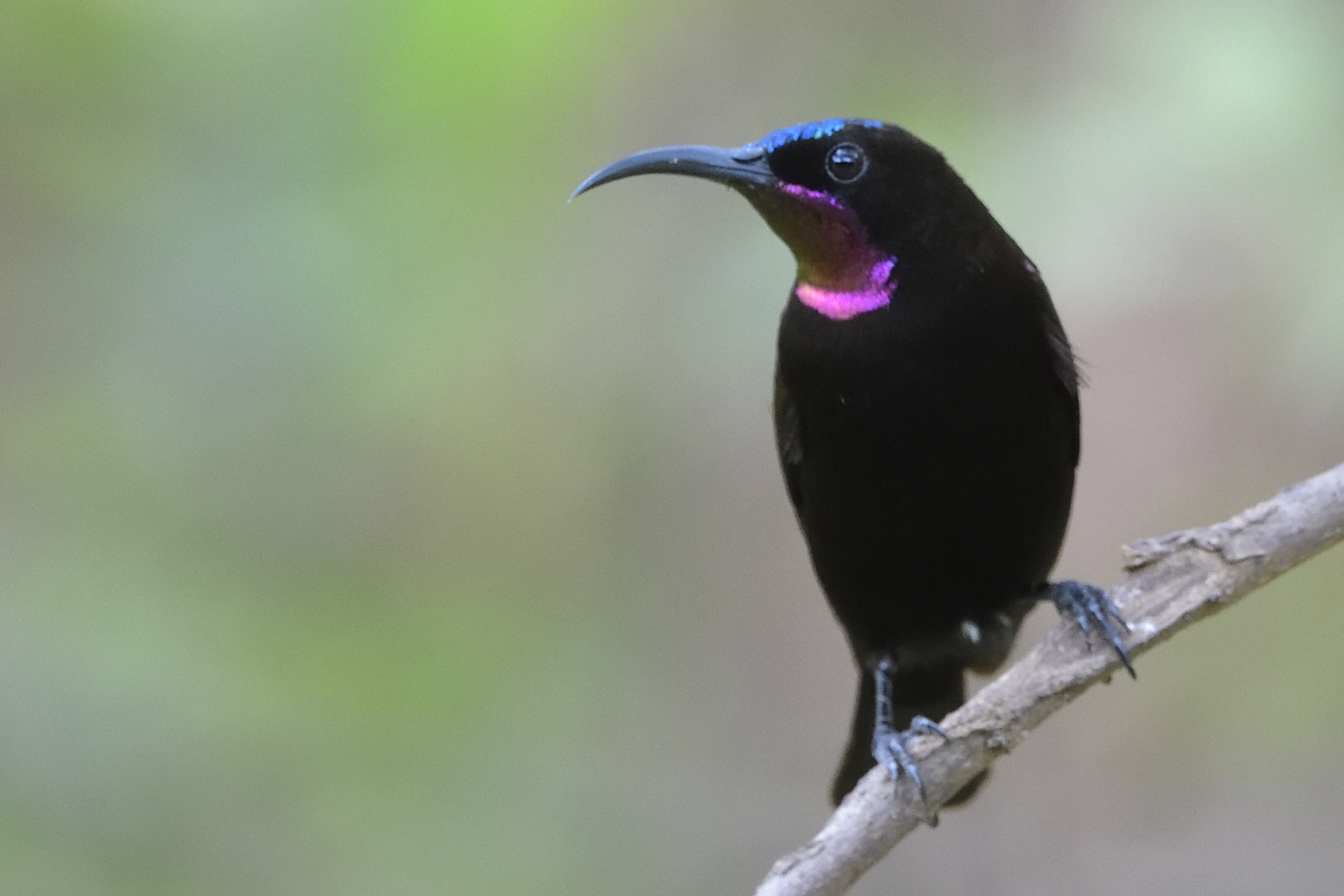
Amethyst Sunbird, Chalocmitra amethystina

At the airport before farewell. Nick, Me and Ray in front of my Green Landy, Maggie T
All in all it was a very successful trip. Nick had sent me a taget list beforehand and from that list I promised him 200 lifers. I believe both Nick and Ray ended up with 226 lifers. We registered around 460 birds on the trip wheas almost 50% were lifers for both of them. Even I managed some photo lifers for Tanzania and my numbers after that trip stands at 856 seen and pictures of 812. Stay tuned for more trip reports. Next one might be a very succesful trip I did in Kenya esrlier in January 2023.